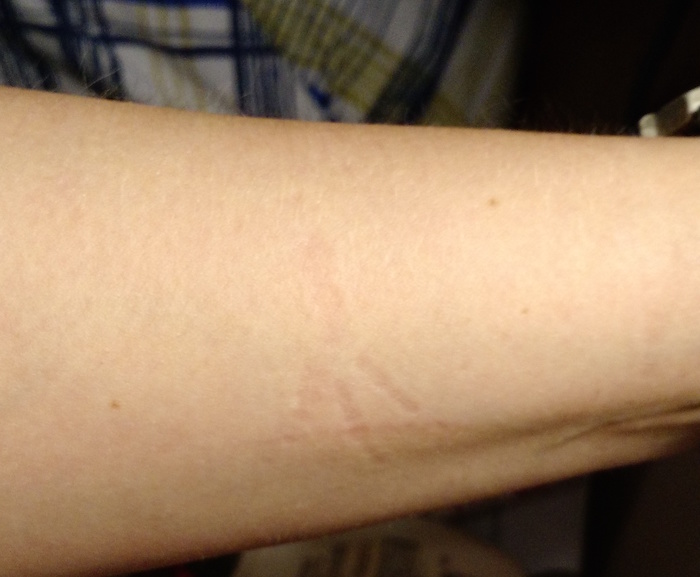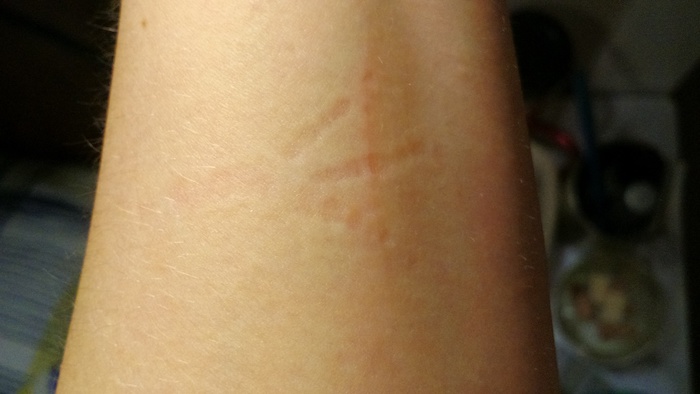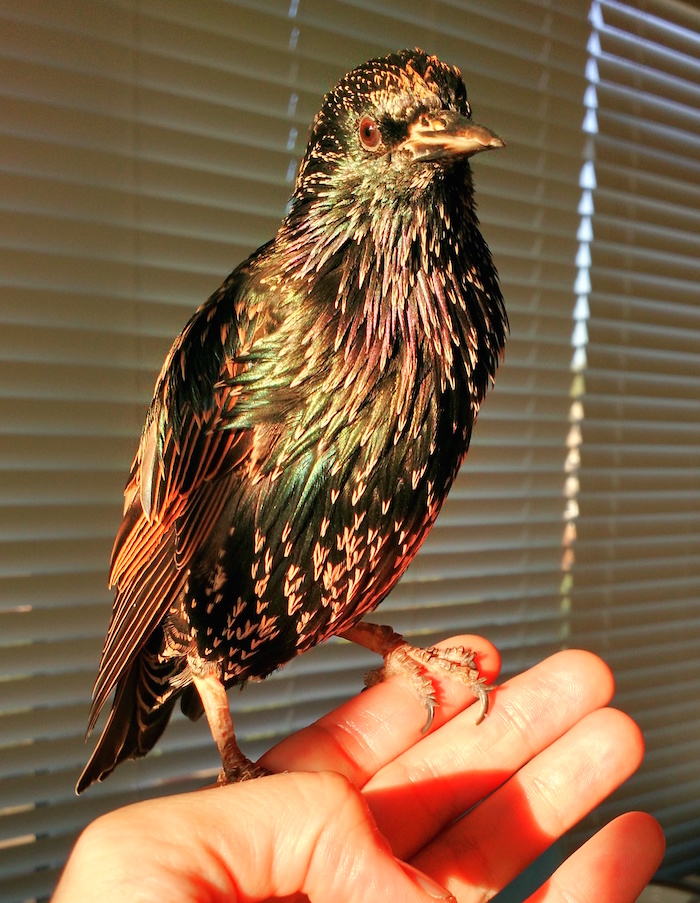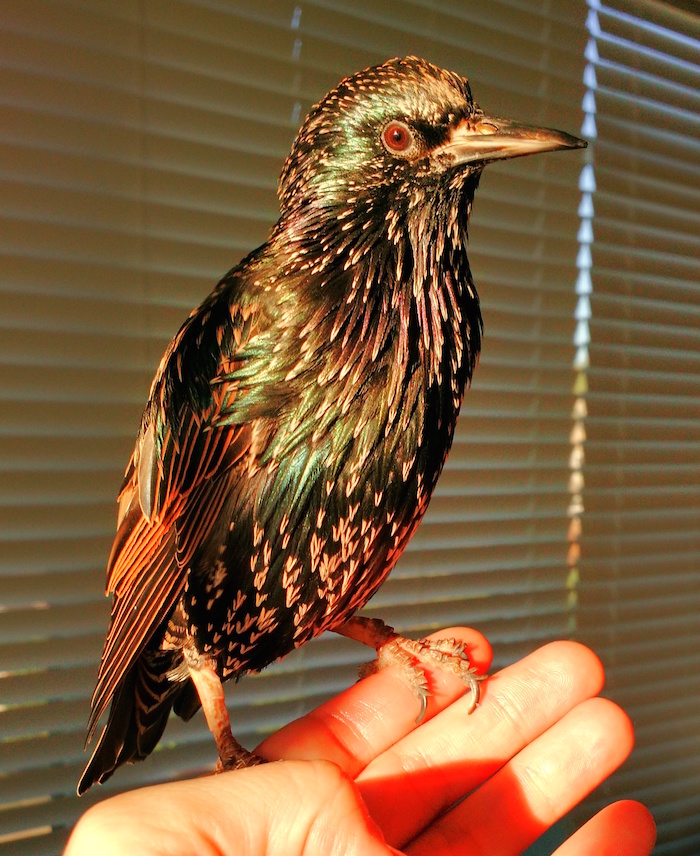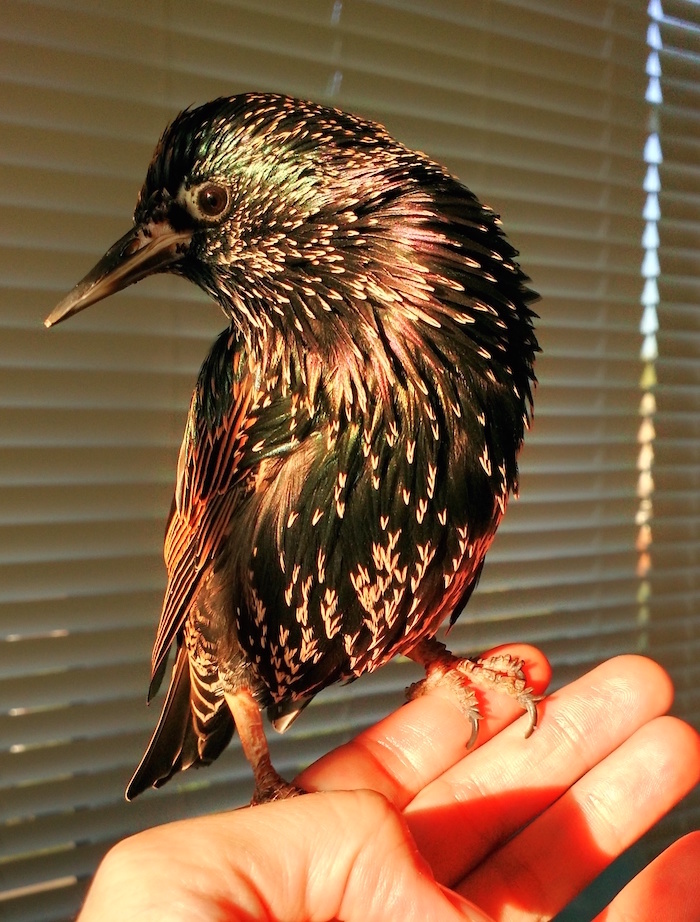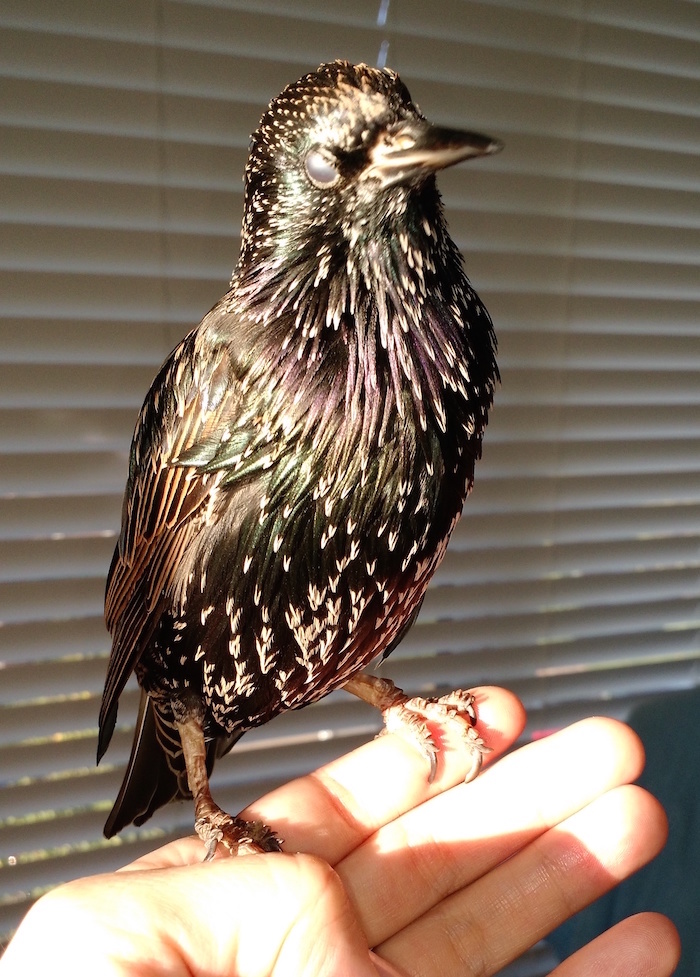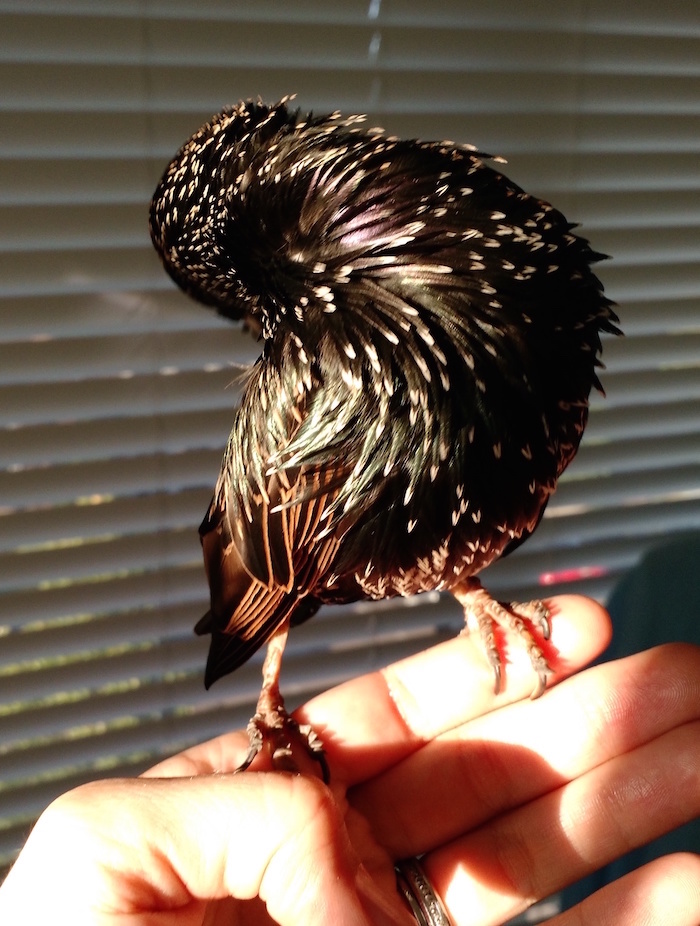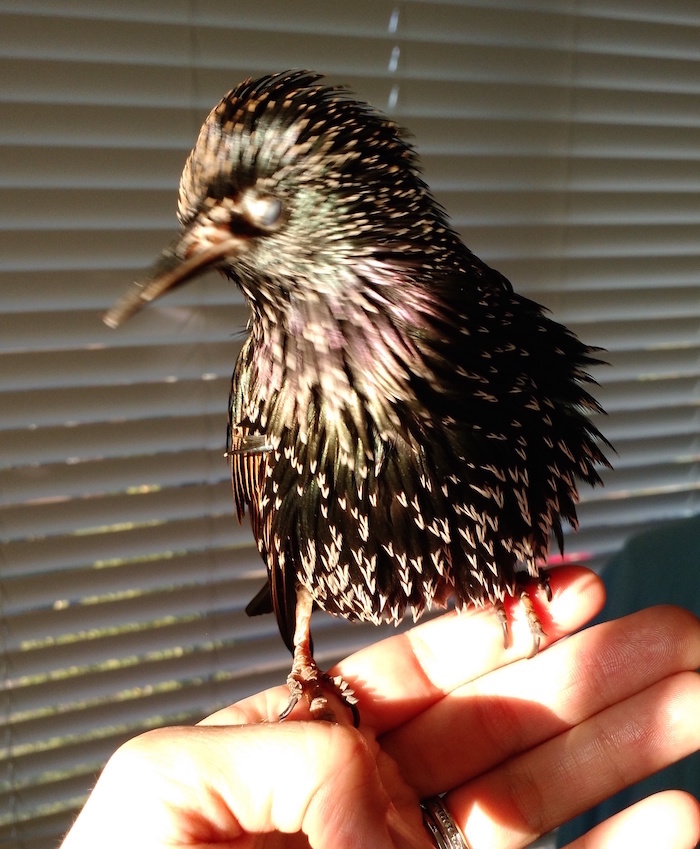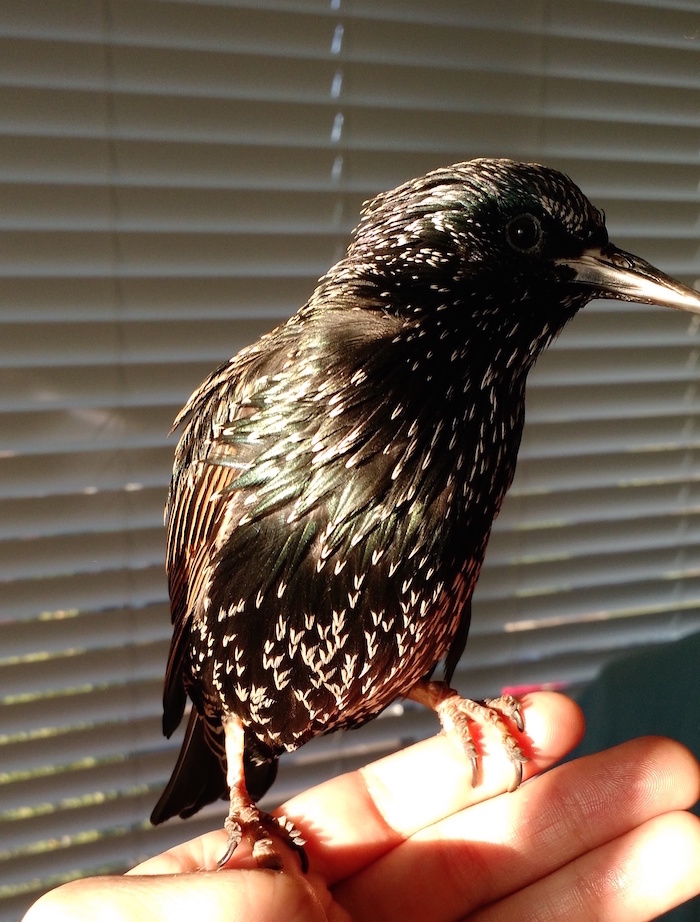
Blog posts featuring
Sirius the Starling
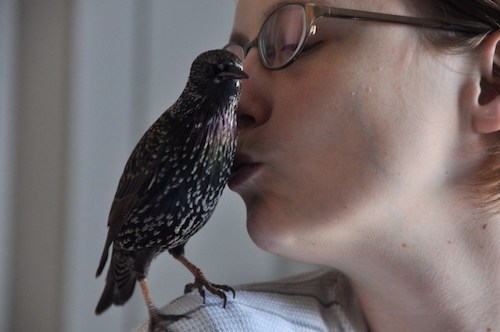

Sirius Marley Black, our new pet
2013/7/21
I have been waiting for this so long.
Yesterday we adopted a new bird!

Siri's healthy new feathers and feet
2013/11/3
Sirius Marley the starling is no longer bald-faced from fighting with other starlings. In the time he's been living with me, he's grown a face full of pretty feathers!
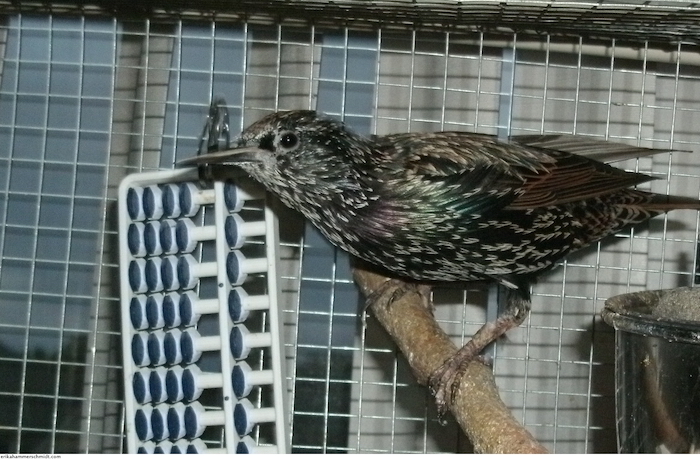
That picture is also the latest in a series of photos showing the improvement of Siri's feet! When we first adopted him, he had pretty severe hyperkeratosis (overgrowth of keratin, such as leg scales, claws and beak), which can be a result of nutrient deficiency or other things that can impede a healthy molt. His leg scales in particular were huge! With good food, sunlight and an aloe gel regimen, he's made a lot of progress:
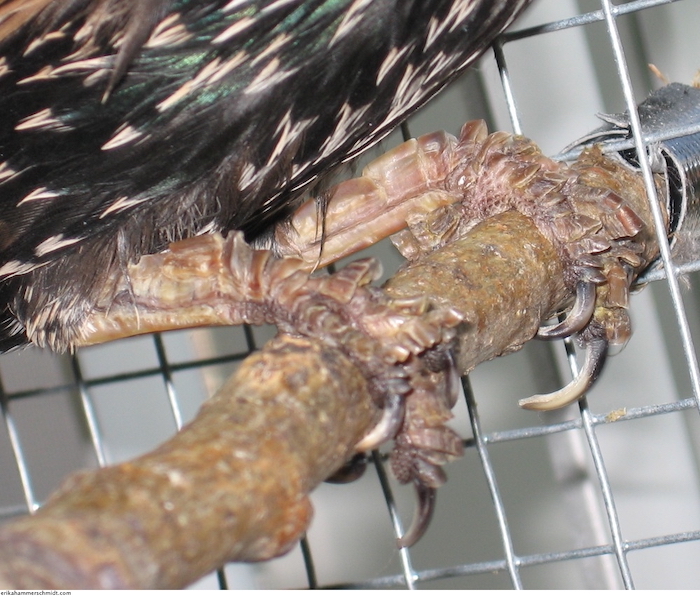
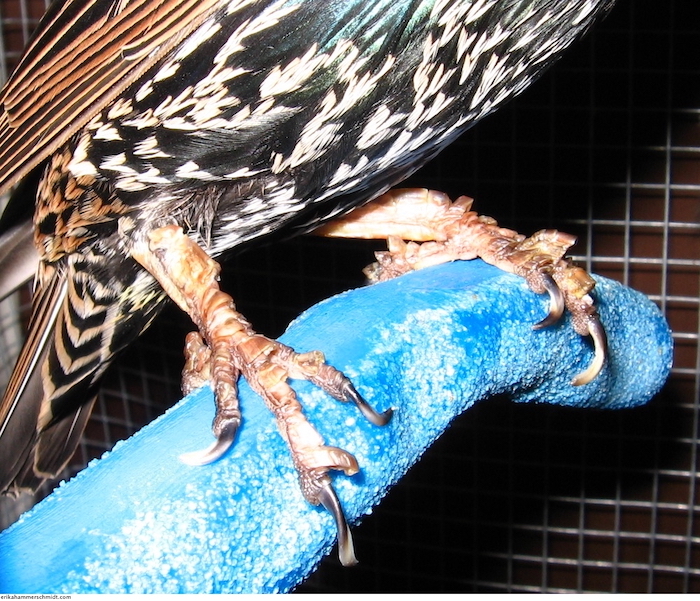
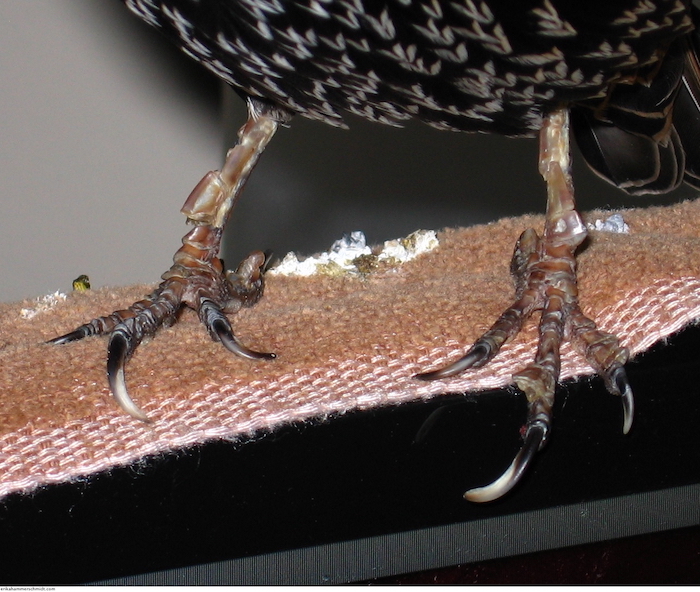
(Update: Another picture added in December)
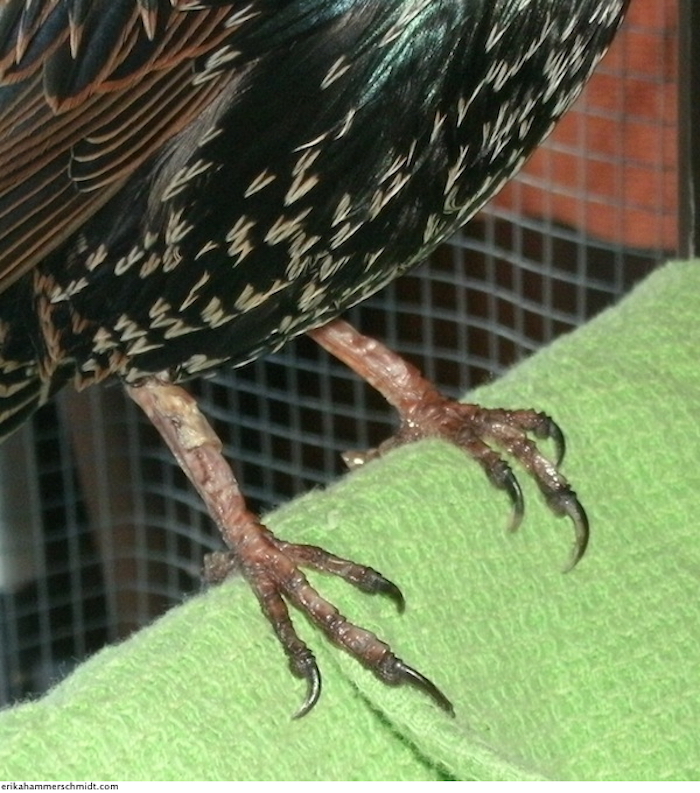
(Update: Another picture added in January)
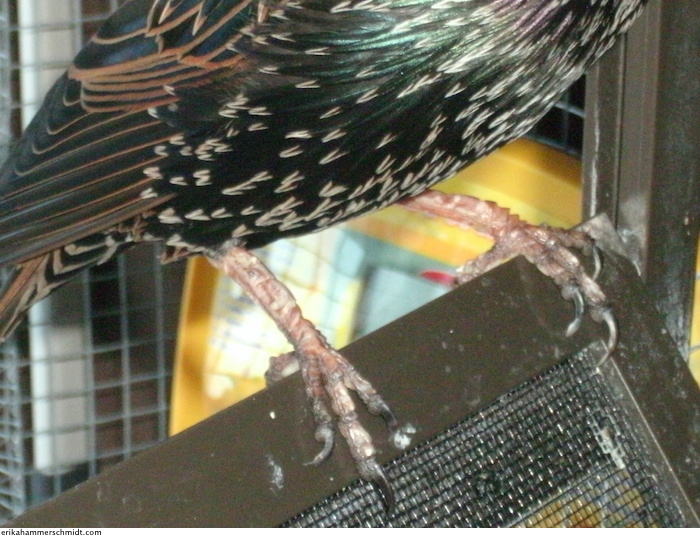

Blueberry massacre
2013/11/12
Sirius Marley eats a blueberry: stab, stab, pry apart, tear into shreds, fling the shreds everywhere, hunt them down and eat them one by one.
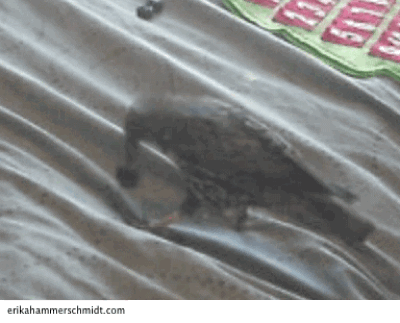

Siri Foraging in an Advent Calendar
2013/11/13
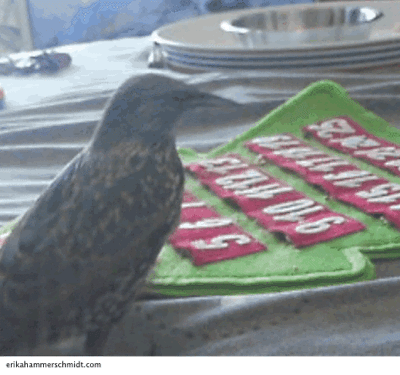
Starlings-- mostly insectivorous in the wild-- love to stick their beaks into small spaces and pry them open looking for food. Sirius Marley does this with pockets, folds in clothing, our mouths, the spaces between our fingers, any little nook and cranny he can find. His current favorite foraging toy is a cloth Advent calendar with 25 pockets, in which I hide treats for him.

Sirius and his name
2014/1/2
I wanted to name my pet starling after a star, and I picked Sirius, but after living with him a while-- and watching some Farscape-- maybe I should have picked Rigel.
He's a greedy little sucker who spends most of his day eating and excreting, and yet somehow manages to be adorable. He's got much more in common with Rygel XVI from Farscape than, say, Sirius Black from Harry Potter.
(Also got a few Ferengi traits, mainly wanting his food pre-chewed for him. He's got no interest in my sandwich until I take a bite, then he's poking his beak in trying to pry my mouth open...)

The animal-hoarder of 1930's Vienna: A review of "King Solomon's Ring"
2014/03/02
I've just finished reading Konrad Lorenz's "King Solomon's Ring," a naturalist's account of his life with a ridiculous number of not-so-domestic animals. It was recommended to me by a guest at a speech, because I had mentioned during the speech that we had just adopted a pet starling. So, of course, I went into this reading experience with the expectation that starlings would be a main feature of the book.
In that respect, I was disappointed, but overall the book has been more fun than I could have imagined.
It was published in 1952, and describes events from much earlier, most of which took place in Europe before World War II. Lorenz was an Englishman living in Austria (having lived in Austria for a semester myself, the setting as well as the subject matter was of interest to me). He, and his wife and children, lived in a house that also contained dogs, mongooses, monkeys, apes, parrots, jackdaws, geese, lemurs, hamsters, water-shrews, crows, an eagle, and any number of other bizarre animals-- mostly not even kept in cages, or if they had cages, they were allowed outside of them most of the time. Lorenz saw his pets as both companions and research subjects; he let them run free partly because he valued their happiness, and partly because he felt he could observe their behavior more naturally that way.
In both the body of the book and the foreword by another author, Konrad's wife is described as saintly for putting up with all this. She's quoted as saying that she managed to tolerate it because she spent more time at her job than at home. But, as another married woman with a fascination for nature and the bizarre, I find myself wondering. Did she put up with it because of a sense of wifely duty? Or did she actually, deep down, enjoy living in a zoo-- as I might-- but feel hesitant to say so in a day and age when no "proper" woman would feel anything but disgust for such a situation?
In the present day and age-- and in the USA-- such a situation, of course, wouldn't even be tolerated by law enforcement. Native birds can't legally be taken from their nests as Lorenz described (though non-native birds like starlings are fair game) and there are very few places to live where you could keep a pet ape or mongoose without some sort of special permit. From his account it seems that his animals were happy, but I can still imagine modern neighbors rushing to call animal control (not to mention child protection services-- according to his narrative, sometimes the only safe place for a child in his house was inside a large cage.)
But his stories of animal behavior are still delightful to read, if one makes allowances for the time he lived in, and the different values of that time.
He gives a fascinating account of the territorial behavior of sticklebacks and cichlids in his aquariums, making the reader see more depth and complexity in these little fish than previously imagined. His story of keeping water-shrews is hilarious, this time not because of the animals' complexity, but because of how simple their minds are, and how absolutely baffled they find themselves when an obstacle in their cage is moved.
For a scientist of his time period, I find his view of animals surprisingly balanced between the extremes of anthropomorphizing them and reducing them to thoughtless and unfeeling automatons. He recognizes that, being distantly related to us, they have many of the same basic drives and instincts as humans, and probably feel similar emotions, but he also frequently reminds the reader that the animals come at things from their own perspective, which is often totally unlike the human perspective.
There certainly are times when I suspect he's jumping to conclusions in his interpretation of his pets' behavior. It's easy to be wrong about the motives for an action, even the action of a close human friend or relative, let alone the action of a creature physically and mentally very unlike us and living a completely different sort of life. He makes the best guesses he can about why his animals do what they do, but his observations are inevitably somewhat hampered by his own attachment to them and the not-quite-natural environment in which he's observing them.
He's also, of course, a product of his time when it comes to errors in the biological sciences. He devotes an entire chapter to the differences in personality and temperament between the breeds of dogs descended from wolves and the breeds descended from jackals-- which looks pretty ridiculous to someone reading in an era when all the genetic evidence indicates that dogs are 100% descended from wolves and none of them have any jackal blood.
Still, for his era, he's very advanced in his understanding of animal behavior, and even when he might be wrong, his accounts are still a lot of fun to read. I only wish he had written more about starlings.
His mentions of starlings are confined to a few paragraphs, in which he recommends them as an easy-to-raise pet for the inexperienced keeper of animals, and describes their infancy, rate of growth, and the diet they should be fed in captivity. He only briefly mentions that they can be affectionate and learn to mimic words.
In the little he says about them, I can see tons of things that would outrage my friends on the Starlingtalk.com forum. The foods he advocates have virtually no overlap with what present-day starling-keepers consider a healthy diet, and he actually recommends taking infant birds from their nests to raise them, which is heavily frowned-on among the starling-lovers I've met online.
But for me personally, the biggest disappointment was that he didn't include any actual stories of life with a starling. He makes it known that he raised them, but sadly, he gives no specific examples. His accounts of the antics of his other pets are so delightful that I think I would have loved some funny tales of the things his starlings learned to say, the mischief they made playing with jewelry and the like, or any of the other silly things that they must have done, if my own pet starling is at all typical of the species.
He does make up for it, though, by giving many pages to the lives of his colony of jackdaws. They're not starlings, but they are similar birds, being very social, very affectionate and able to mimic speech. The hierarchy, social rules and interactions within his jackdaw society are utterly fascinating and lovingly described, reminding me a lot of the descriptions of raven society in the more recent book "Ravens in Winter."
Even though starlings were somewhat neglected in his narrative, I've found that a side effect of reading Lorenz's prose is a tendency to observe my own pet as he would. Whole paragraphs of Lorenzian naturalist description pop into my head from time to time as I watch Sirius the starling, and I find myself wording my own my observations in a 1950's English scientist's writing style:
"On the whole, Sirius prefers for his sustenance such foods that are white or very light-coloured, or black or very dark-coloured, and regards with suspicion any proffered fruit of a brighter orange or red hue; this, I believe, owing to the proclivity of the starling for feeding primarily upon insects in the wild, and his instinctive knowledge that the insects upon which a wild starling may most safely feast are those of dark colouration, such as the ants and house-flies, and the black beetles which are ever present in a garden, as well as those of light colouration, as the larvae of such beetles, and fly-maggots-- the species that bear patches of bright colour most often doing so to signal to their enemies that they are venomous, or at the very least, foul-tasting."

Vicious predator
2014/03/20
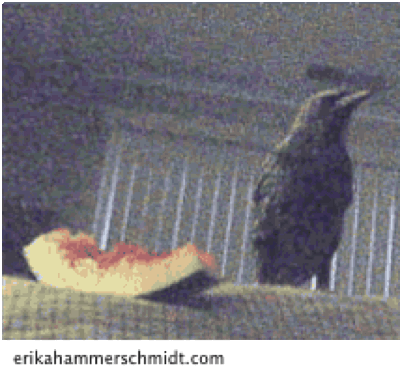
The prehistoric Terror Bird rips flesh from the dinosaur it has just slaughtered. (Or, Siri the starling likes watermelons.)

A year of Sirius Marley Black: Starlings in review
2014/06/15
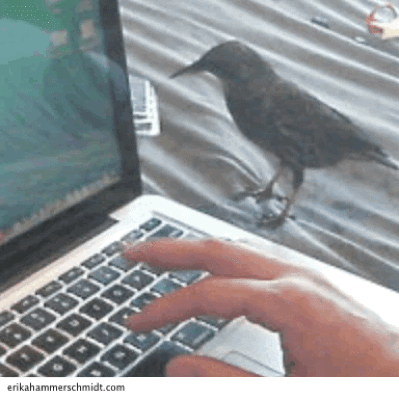
Several months after our parrot Rain Man went to his new home, the mixture of sadness and relief turned into empty nest syndrome. I had expected that I would want to adopt a new pet someday, and after all that time I was finally starting to feel ready.
I knew we had to choose carefully. I still felt guilty that we had given up our previous pet, even though his life and ours had become irreconcilable and he was undoubtedly happier with his new family. I knew how much of an upheaval it is for an animal to move from one home to another, and I wouldn't wish it on any creature. I wanted my next pet to be for life. I wanted a bird-- birds are what I relate to-- but it couldn't be a bird with the same needs Rain Man had.
My partner's parental instinct, like mine, is focused mostly on pet birds, but she didn't feel as strong a need for a bird in the house as I did. Nevertheless, around the time I felt ready, she agreed she was ready too.
Secretly, I had wanted a starling for a long time. It wasn't a secret, but I didn't discuss it with a lot of people at the time, because starlings are such unpopular creatures, and almost no one I knew would consider one as a pet.
From childhood, I'd been aware that they are kept as pets sometimes. One of my favorite books as a kid was "Arnie the Darling Starling"-- which, despite having a title like a children's book, is actually a pet memoir like "Oogy" or "Marley and Me." I grew up knowing that starlings can do quite well in captivity, and that they can learn to talk like parrots, and become very affectionate with their human adopters. I knew that in the wild they're considered horrible pests, and so there is no law against taking them from the wild and keeping them, as there is for protected bird species.
Early in our relationship, back in 2005 when our pet was the dear departed Popcorn the cockatiel, we once found an injured starling on the sidewalk. It was disoriented and moving slowly enough for us to pick it up, despite having no visible wounds. There had just been a storm. We hypothesized that the bird had landed on a wet, insufficiently insulated power line and gotten a bad shock.
The poor thing didn't live long, but in the few hours it was with us, we went online and found a starling Yahoogroup... enough for us to learn that there were lots of others who had taken in starlings, and places where people shared information and resources on how to care for them. I remembered that, even though adopting a starling wasn't a practical option for us until much later.
And last year, it became real.
Times had changed a bit. The starling Yahoogroup no longer came up when I searched for starlings online. But there was a website, www.starlingtalk.com , with a message board for starling discussions. There was a recommended diet, comprised of dog food, poultry mash, and powdered egg. There were guidelines on what sort of cages and toys a starling needed.
And there was a board for people to post if they wanted to adopt a starling, or give one up for adoption.
Unlike parrot-owners, starling-owners are mostly people who found a mysterious baby bird, managed to keep it alive, and then were surprised and delighted to find that the grown-up bird could talk, made a pretty awesome pet, and didn't want to be released into the wild. Starling-owners usually stumble into the whole thing without asking for it, but they are, for the most part, a happy and unregretful bunch.
With good reason. Starlings are friendly, funny, loving, talkative, easy and cheap to care for, and so little that they couldn't hurt you even if they wanted to.
On the message board there were some people looking to rehome their starlings, but they tended to get adopted quite fast. The balance between people trying to give up a bird and people trying to adopt one was much more equal than it was on parrot forums. And, of the few who wanted to give one up, I didn't see any who were rejecting their bird because they couldn't get along with it.
Other birds not getting along with it-- that wasn't unheard of. When someone finally contacted me about my wish to adopt a starling, the bird she offered was a four-year-old male who was up for adoption because he fought with one of his cage-mates.
Marley, as he was called, had fallen from the nest as a baby and been raised by a wildlife rehabber. She had intended to release him, and avoided petting and cuddling him as a baby, for fear it would cause him to bond with humans instead of his own species. But, cuddling or no cuddling, he bonded with her anyway. When it came time to release him, he refused to go.
So for three years or so, he was her pet, along with another starling she'd raised, named Thurston. But she became unable to care for them, for health reasons of some kind. He and his cage-mate were taken in by another woman who was seeking a companion for the starling she had.
Thurston was a good friend for her bird. Marley wasn't. He and the stranger attacked each other again and again, pecking and plucking out each other's feathers. Marley was the main aggressor. His face developed a few bare patches, but in this picture, he's clearly thinking, "You should see the other bird." From what I'm told, that one's face became almost completely bald.
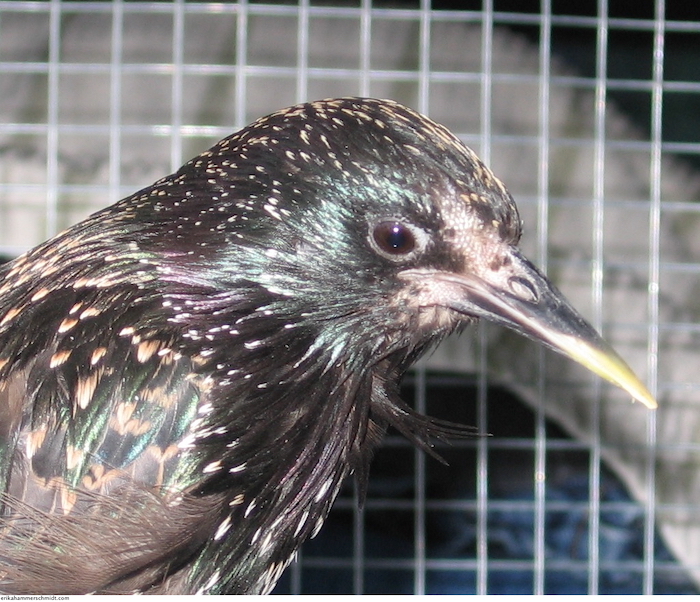
After a year of this, I got an email from his adoptive family.
I had prepared for this like crazy. Before I even knew when or from whom I was going to adopt a starling, I had stocked up on dog food, chicken food, egg powder, applesauce and dried mealworms to feed him, and all the recommended elements of an avian first aid kit. After two failed attempts at buying a suitable cage and one failed attempt at making one, I had managed to put together a pretty good aviary out of chicken wire, latchable dog doors, natural branch perches from a nearby park, and the frame from an old folding wardrobe.
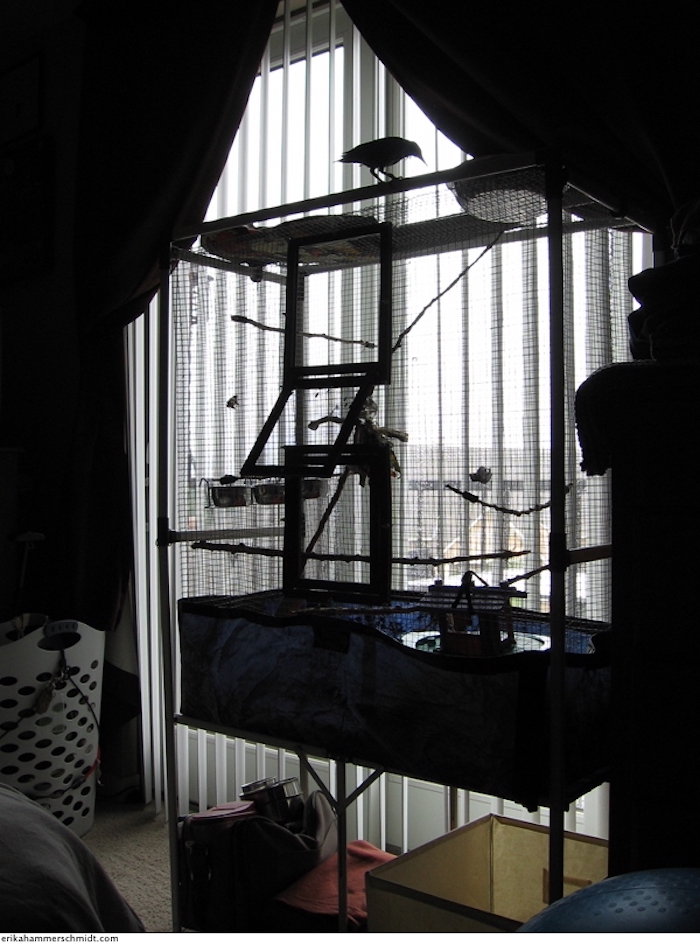
I had even picked a name already. In fact, I'd picked the name years ago, around July of 2010 when we were dreaming pipe dreams of moving to Tower, Minnesota and starting an art gallery. I had imagined the focal point of the gallery being a huge aviary with talking starlings in it. They would all be named after stars: Alpha Centauri, Arcturus and Sirius (Alfie, Arkie and Siri for short).
By this time, I had settled on the name "Sirius" for the one starling I could realistically have. Since our Tower fantasy, "Siri" had become an even more fitting nickname for a talking bird, with the 2011 launch of the iPhone 4S. Besides, it was the year of my 32nd birthday, which is 100,000 in binary. The starling I adopted was going to be my extra-special gift for this mathematically significant birthday... and Sirius is a binary star system.
My eagerness was overwhelming at this point. I'd been disappointed once already, when someone in another state had thought she would be able to send a friend to bring me a young bird she'd rescued, but the travel plans fell through and I never heard from her again.
And I was disappointed a few more times as we tried to figure out a date for Marley's adoption. But after two or three rain checks, a woman and two young girls finally showed up at my door, with a frantic little bird scurrying around inside a tiny carrier.

I believe this was the first photo I ever took of him. With effort, we had just relocated the panicked little creature from his carrier into the big cage I'd built for him, and he was perched on one of the branches near the top, getting his bearings.
That was how he entered my life, a nervous and disoriented little thing with bald patches on his face, a funny upward-curling feather under his chin, and chunky overgrown scales on his feet. Sirius Marley Black.
The lady who gave him to me said that he didn't adapt well to new things. Perhaps he hadn't, in her experience. She also said that his previous owner had considered him a not-very-tame bird, but with her, he had opened up and was happy to follow people around and perch on them. Perhaps his personality depends on his environment.
With me, he seemed to adapt just fine. Within an hour of entering his new cage, he took a blueberry from me as I shoved it through the chicken wire. Soon he was eating his ground-up dog-and-chicken-food mix from the bowl, sipping his water, and sampling his applesauce.
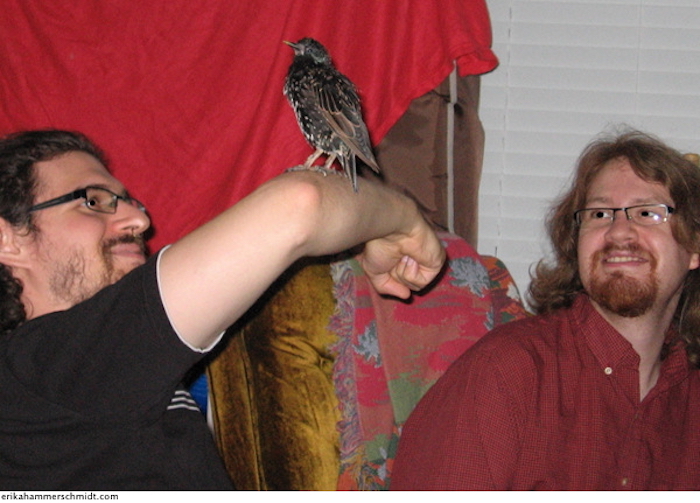
Starlings are extremely social. In the wild, they live in enormous flocks called "murmurations," which move like living clouds. Look it up; there are videos online, and they're amazing to watch.
Sometimes I feel sad that Sirius will never get to be part of one of those. But he doesn't want to; he was raised by humans, and feels that we are his flock.
A starling in captivity is kind of like a human in modern society. Humans, too, are a very social species by nature. Our hunter-gatherer ancestors spent nearly all their time in each other's company. But in modern times, humans often live lives where we spend most of the day alone, or at a job where we do mostly-solitary work. It's unnatural, but we get by. We live for the time when we get off work, and spend the evenings and weekends with people we care about.
Sirius has adapted to a similar life. When we're away, he keeps himself entertained by singing, playing with the toys in his cage, and listening to music I leave on for him. But when we get home, he's always happy to see us.
Within a few days after his adoption, he was tame enough to perch on us and all our friends. Starlings aren't cuddly, but they're very friendly. One day four of us played a game around the dining room table, all wearing safari hats so he wouldn't poo on our heads and get his feet tangled in our hair. He happily jumped from hat to hat all evening. Heads are a starling's favorite perch.
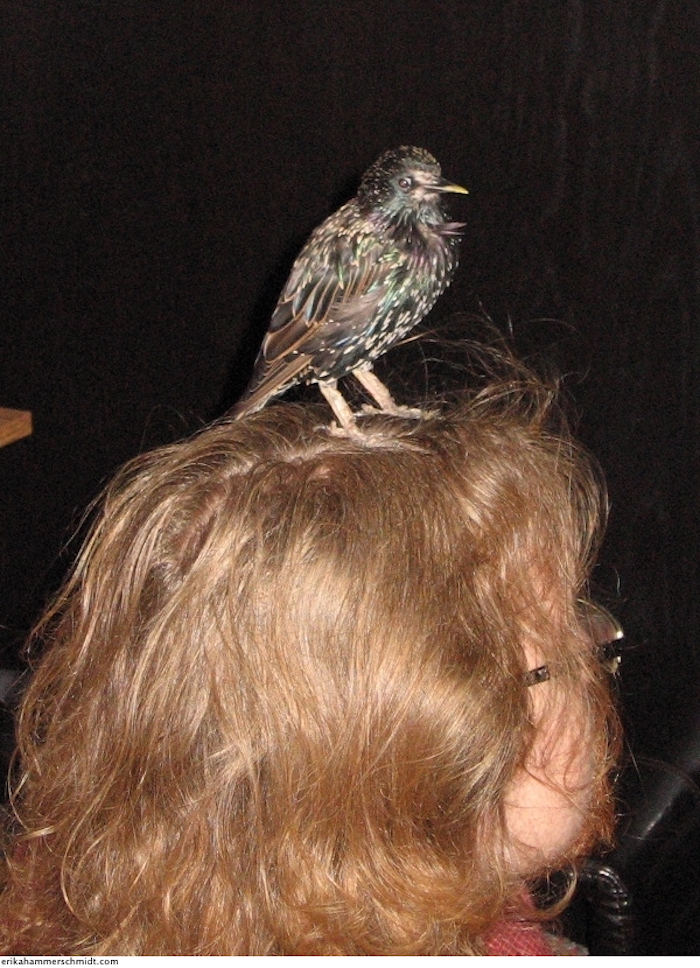
Some starlings will sit on someone's head and act as if they're taking a bath in the hair. Sirius doesn't do this, but water baths are one of his favorite things ever.
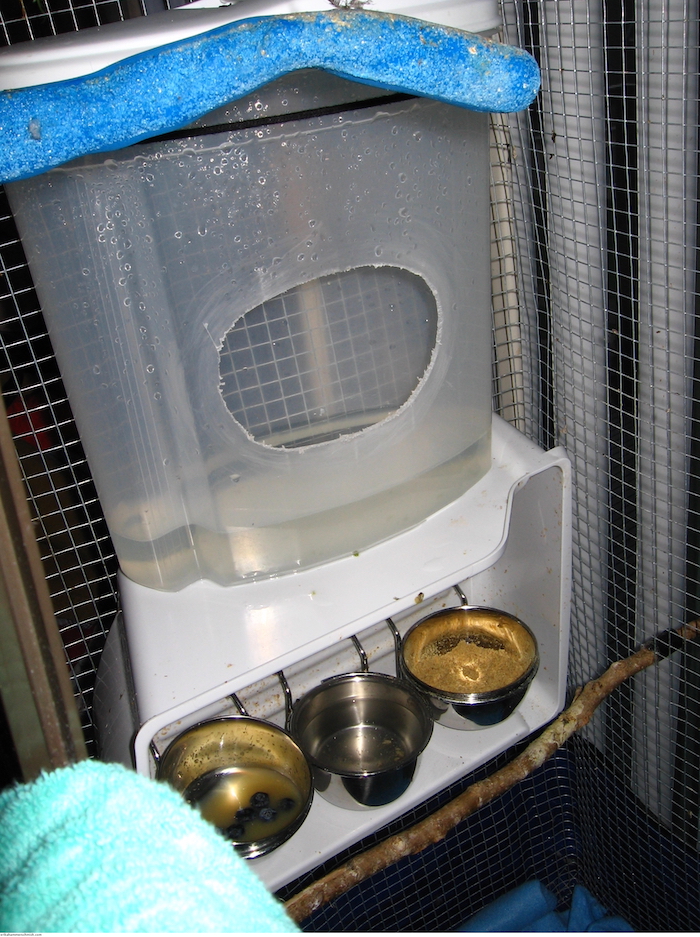
I made a bathtub for his cage out of a big plastic pitcher with a hole cut in it, so he wouldn't get water everywhere when bathing. He uses it often, but he prefers the bath bowl we keep in the shower.
A starling bathing is amazing to watch. It's a blur of fluttering and splashing, faster than a human could ever move-- kind of like a dog that shakes itself after a bath, except the starling is doing it to get wet, not dry. In the absence of barriers, a person ten feet away could feel water drops from it.
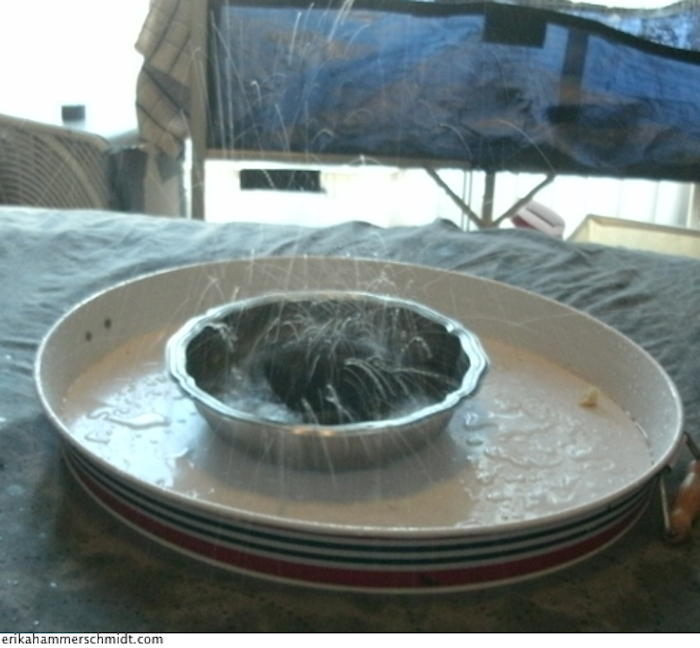
And just as quickly as it began, it's suddenly over, and zoom! The starling is done bathing, and rockets from the bath bowl across the room to another perch. Usually he'll make several flights from place to place immediately after his bath, all with the same sort of frenetic, hyperactive too-fast zooming motion-- maybe as part of his effort to dry himself off. He's on the cage! He's on my head! He's on the cage again-- now he's on the door!
Hyperactive, inquisitive, curious-- that's my Siri. When he's not flying crazily around, he's poking his face into everything, looking for treasure or bugs or whatever. If I'm lying in bed watching a movie, he'll come and crawl all over me, poking his beak at my clothing. He's even tried to look down people's pants.
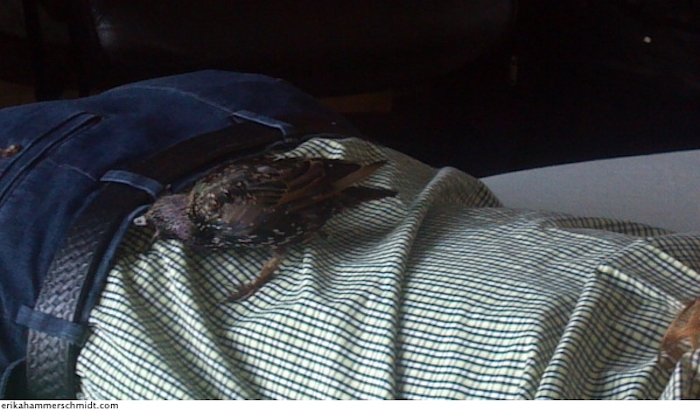
Starlings love to pry things open with their beaks. Folds in clothing, spaces between your fingers, your mouth (especially when you're eating), any small crevice they can find. His favorite toy now is an Advent calendar I got him during the Christmas season. I hide small treats in the pockets, and he happily goes around poking and prying in each one.

Like most starlings, he doesn't like being touched. He'll cuddle on his own terms: perched on my shoulder, snuggling against my neck, playing with my hair, just as long as he's in control and no hands get anywhere near him.
Only rarely will he let me pet him without complaint:
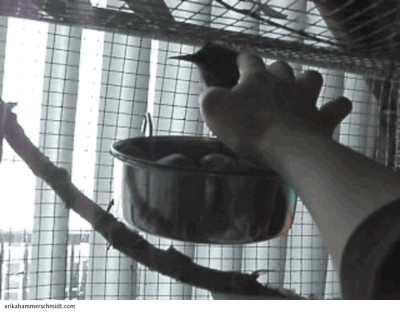
He doesn't always hate hands, mind you; he'll play with them if he is the one doing all the playing. One of his sweetest expressions of affection is to land on my hand while I'm working at the computer, and start poking at my fingers. Sometimes he saves me from wasting my whole day on the internet; sometimes he just messes up my typing.
Poke a finger at him and he'll make the most hilarious sounds of starling rage. A weird thing about starlings: they don't express anger with instinctive sounds natural to their species. They almost always seem to use mimicked sounds. I heard of one person whose starling would make an angry parrot sound she'd learned from the other pets, whenever a finger was poked at her. I heard of another starling who would say the words "I've got a question!" when its nails were being trimmed.

As winter approached, Siri's new plumage came in, and his face was no longer bald. His feet have also become healthier, having shed the overgrown scales with the help of aloe gel rubbed on his toes every day. God, does he hate when we do that! He forgives us afterwards with a grace that Rain Man could never approach-- but when we're doing it, he's a noise-box of angry and adorable protests.
Sirius doesn't have many words to say, and the ones he says are mumbled baby-talk. He says things that sound vaguely like "Hello," "Hi sweetheart," "Pretty bird," "Birdy," "Crackers," and something that might be "Pretty Chester."
We have no idea who Chester is, if anyone. He might have made it up, out of sounds from other words. He does love to rearrange sounds. Sometimes his "Pretty Chester" sounds more like "Poor Chester," sometimes like "Peaches," sometimes like "Purchase," sometimes just the word "chess" amid a bunch of mumbling.
A starling song has some instinctive starling noises in it, mixed with sounds the bird learned from various things in its environment. When Sirius sings , it's a fantastic medley of chatters, whistles, clicks, shrieks, melodic bubbling-water sounds, a phone ring, a dog whine, and some yapping and growling like a little dog that's having a lot of fun playing tug-o-war. Plus a few "Chesters" thrown in here and there.
And, singing or talking, and especially when scolding us for poking a finger in his face, his little pointy wide-open beak is one of the funniest-looking things ever.
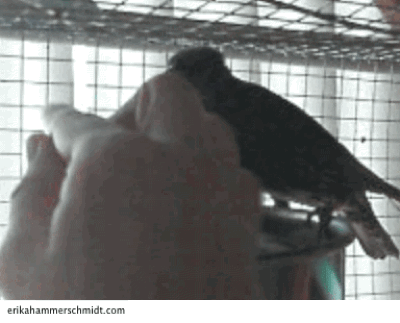
If I eat in front of him, he shows an almost hilarious level of greed, zooming to my shoulder and shoving his beak in my mouth to try and get my food. Some foods he acually seems to prefer when they're in my mouth. He'll try to eat anything if he sees me eating it; I have to have my non-bird-safe snacks in a different room.
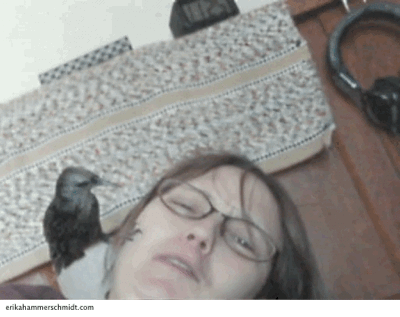
The starling forum recommends a certain diet for adult birds, but it can be varied depending on people's needs. Some feed their starlings the dog food and chicken feed in one bowl, and chopped hard-boiled eggs in another. Some put water in the mix because their birds won't eat it dry. But this is the recipe I use:
2 cups dry dog food. (The protein amount should be in the 25-32% range, and the fat should be in the 10-14% range. Make sure the first ingredient is some type of meat. Poultry is fine; a starling is no more related to a chicken or turkey than you are to a cow or pig.)
1/2 cup chicken feed (the pellets for egg-laying hens, often called "layer mash"-- not the medicated mash for chicks. Yes, starlings can eat chicken food even though they're not closely related to chickens.)
2 tablespoons powdered egg (available in large cans; I use the Honeyville brand. Yes, they're chicken eggs; see above.)
Mix all ingredients together, and blend to a powder in food processor.
Every day, feed two tablespoons of the dry mix in one bowl, two tablespoons of unsweetened applesauce in a separate bowl, and about 2/3 cup of water in a third.
Treats can include bugs, bits of cornbread, chopped nuts, and especially blueberries-- which Sirius attacks and tears to pieces with a frightening level of energy.

That's the icing on the cake of starling-parenthood joy-- how sustainable it is. A bag of dog food, a bag of layer mash and a jar of powdered egg will feed a starling for a long, long time, saving money and minimizing any effects that pet-food production has on the environment. Starling droppings aren't messy and smelly like dog poop; they dissolve almost instantly in water. I use polar-fleece fabric as a cage liner and machine-wash it. But using your junk mail is fine too; it's free and biodegradable.
Dried crickets and mealworms from a pet shop make good treats, but your free and plentiful household bugs can serve the same purpose. In the wild, starlings eat mostly bugs. (Just avoid any bright-colored ones, which are often poisonous. And stay away from worms and caterpillars; they're the most common things for parasites to lay eggs in. Small moths and beetles are usually fine.)
Even the procurement of the starling itself is earth-friendly. Starlings aren't bred in buildings that draw power, produce waste, and affect the ecosystem around them. They're bred by their parents in nests in the trees. And most starling-keepers don't even upset the parent birds by taking in the baby, because it's usually one that the parents rejected anyway.
Nature can be cruel. In wild bird nests, the smallest and weakest babies are often pushed out, because birds can't afford to expend the effort of feeding unless the offspring shows great promise of survival. Sometimes it's the parents who eject the unwanted baby, sometimes it's the siblings, but almost always it will be pushed out again if someone tries to return it. (This is probably the origin of the myth that birds will reject any nestling that's been touched by humans.)
But even if taking in a starling did reduce wild starling populations, it wouldn't be any kind of ecological disaster, because starlings are not in the least bit threatened. They are a plentiful bird, living on small amounts of plentiful and easy-to-obtain necessities. It's almost ridiculous how small the carbon footprint of a pet starling is.
On Youtube, there are starling-haters who go around posting trollish comments on any cute videos of pet starlings. Things like "I'd shoot it if I ever saw it," and "Starlings are rats with wings."
They're picking the wrong target. Pet starlings are harmless. Fine, so they think wild starlings are a menace to the ecosystem... well, so are humans. Anything they accuse starlings of doing, humans do a hundred times worse. How would you like it if that tired old science-fiction trope played out in your home: an alien appears, recites a list of atrocities committed by humans, and threatens to execute you for the crimes of your species?
Hey, Youtube trolls threatening to shoot someone's cute pet starling-- you are that alien. Our pet starlings don't threaten native birds or eat farmers' crops, any more than you personally have committed genocide. In fact, you should thank us for keeping a starling out of the wild, where you think it will do so much horrible damage.
He likes it better here anyway.

Curing hyperkeratosis
2014/06/22

This is a post about the amazing progress we've made on the health of our bird. It goes into more detail about the overgrown foot scales we mentioned before, and the exact process we used for treating them.
If you don't like looking at pictures of scaly bird feet, both healthy and unhealthy, then this post is not for you.
This is where I found out about overgrown scales on the feet of starlings. They can be caused by a deficiency of vitamin A, or a deficiency of protein (which is needed for absorbing vitamin A). They can also be caused by other things that can impede a healthy molt, like a lack of sunlight or bathing water.
It's normal for starlings to shed their scales. I think usually it happens during the molt, and usually just a few scales at a time are shed, over a long period of days, so you wouldn't necessarily notice it. But if the bird is not able to molt properly for some reason (nutrient deficiency or whatever) the scales can get overgrown.
This is the third home Sirius Marley has had, and in his first home he ate a food without the proper ratio of fat and protein. During the time he lived in his second home, he's said to have improved a bit, but he still had insanely overgrown scales when he started living with us.

Here are Siri's feet shortly after we adopted him, in July of 2013. He looks like some monster from a video game.
On the advice of some great people on the Starlingtalk.com forums, I started an aloe vera treatment in hopes of softening his scales. Every day, I mix his bath water with a generous splash of aloe liquid , intended as a supplement in drinks. After his bath I catch him and rub his feet with a very pure aloe gel (he hates this, but he forgives me afterwards!)

Here he is on September 4th. After a month or so of the aloe treatment, he'd shed a lot of the big scales, though he still had quite a few left-- most notably on the end of his right middle toe and the middle knuckle of his left middle toe.

September 20th. By this point he'd shed the long scale on his right foot and the ridiculously tall one on his left foot, but he still had a few stick-out toe scales left, plus the big scales on his legs and the "spurs" on his back toes.

Here he is in December. He had just shed that last big scale on his right leg. It must have been itching, because he was pecking and scratching at his leg, and finally he picked the big scale right off, threw it down and attacked it as if it were a blueberry! He didn't eat it, he just tore it into pieces. I think he was mad at it!
All that was left at this point was a little bit of loose keratin where the big leg scale used to be, and a spur on his left back toe.

January 2014. By this point, he had finally shed both the back-toe spur and the last bit of loose keratin on his right leg.
This marks what I'd call a complete recovery, since all the excess keratin has been shed. Of course, the scales he has now are strangely shaped, from being underneath those big chunky scales for so long. Over his next several molts, they may return to a more normal shape, and if so, I'll post more pictures.

Sirius the Starling takes the Ice Bucket Challenge
2014/08/25
So Sirius stepped up and tried it.
He'll take a bath in ANYTHING. Well, almost anything. Maybe he had to wait until the ice melted; so what. He's adorable.

Sirius the Starling: the 6-inch-tall pianist
2014/09/07
My first video of Siri playing his piano. His training is going well, but he's still a little bit shy about it.
I will post more videos as his skill improves.
(Sorry about the watermark; I am using a free version of this video editing program. When I have better videos-- after more piano lessons-- I'll either buy the program or use a different camera that doesn't insist on making 3gp files that can't be edited in iMovie.)

Review of Arbico Organics
2014/09/28
So, from time to time I review things on this site. Sometimes books, sometimes programs. Today, it's bugs.
Full disclosure this time does not require saying that the producer of the bugs has promised me anything in exchange for this review, because it hasn't. I chose to write this on my own, because this company can always use more business, and I like it so much that I really, really want it to stick around.
The website Arbico Organics came to my attention when I was searching online for treats for my pet starling, Sirius. For those who aren't already aware, a starling is a mostly insectivorous bird in the wild. As pets, they can live quite well on a diet of dog food and poultry mash, but Siri's favorite treats included dried mealworms and crickets from the pet store.
However, these posed a few problems. He liked to eat a LOT of them, especially when I was training him to do tricks like playing the piano.And despite being insects, dried crickets and mealworms are not actually healthy snacks for a bird. They are mostly fat and indigestible chitin. Eating a whole lot of them is very unhealthy.
In addition, a 1.7-ounce jar of them at the pet store was in the $8- $10 range, usually the upper end of that range. At the rate he went through them, they were simply not worth the cost.
So I went looking for a healthier and cheaper starling snack. I focused on professional suppliers instead of trying to catch my own bugs to feed him, because wild bugs can carry various pesticides and parasites, and besides, I didn't have the time to go catching that many.
Eventually, I found Arbico Organics' Fly Delight.
This was a bag of dried, dead houseflies. And it seemed to be my wish come true. On their feeder insect page , Arbico Organics claimed that their pet treats "provide a natural varied diet that is easily digestible, and will not cause problems associated with chitinous, exoskeletal materials." They carried no crickets or mealworms, but lots of flies, which have a thinner and softer exoskeleton. And they appeared to be raised in a pretty safe environment, unlikely to be infected with any diseases. Looked like a healthy snack to me.
The Fly Delight cost $6.50 for 0.20 ounces... more money per ounce than the mealworms or crickets I'd been buying. But in bulk, it was different. A 1-pound bag was $34, plus enough shipping to add up to $45.97. If I were to buy enough pet-store jars of crickets or mealworms to make up a pound, that would be nine or ten jars at over $8 apiece, for a total well over $70, and probably in the $80 to $90 range if I weren't lowballing the prices. The Fly Delight was not only healthier, but close to half the price if I bought enough at once.
So I did, and when it arrived, I was impressed at the size of the bag. I'd had no idea that a pound of dead flies took up so much space! By volume, I was getting quite a lot for my money. This was going to last me a very, very long time.
I was also surprised that the text on the bag recommended refrigerating them. I wasn't sure why; dried flies would probably be fine on the shelf, as long as it wasn't too hot or humid. But just to be safe, I put them in a big container and stuck it in the back of the fridge, saving a handful of them in a small jar to keep close at hand.
Sirius loves them! In fact, at first he loved them so much that he wouldn't even do tricks while I was holding them, because he couldn't tear himself away from standing right next to them and staring directly at them! Eventually, he got used to them enough that I could use them as training treats, but he still counts them among his favorite things ever. As a starling snack, they are an absolute success.
While researching Arbico Organics, I found out that most of its business is not related to pet treats, but rather live bugs used in biological warfare against garden pests! They sell ladybugs, lacewings, nematodes, and lots of other beneficial organisms that eat things you don't want to have on your plants.
This was of interest to me, because my windowsill garden was suffering from a bad spider-mite infestation. I could hardly get any beans out of my bean vines before the spider mites ate them alive, and my tomato plants would barely live to maturity at all. I had tried cleaning the leaves with a spray bottle of water, and another spray bottle with some soap and rosemary oil, but it was having limited success, and with Siri's delicate avian respiratory system I didn't want to spray harsher chemicals indoors.
I was quite interested in the Neoseiulus Californicus mites, which not only eat spider mites, but can survive during shortages of spider mites by eating other small arthropods and even pollen. They cost more than other spider-mite predators, but they seemed worth it because they wouldn't immediately starve to death after they ate most of the spider mites, so they could potentially keep the scourge under control for a very long time.
Still, I was hesitant to spend $82.06, including the required overnight shipping for live organisms, when we were not in the greatest financial situation.
I bemoaned the whole thing to Sibre Collard, who surprised me with a wonderful offer. He hadn't been sure what to get me for my birthday or Christmas, and seeing that it was about halfway between the two, he offered to buy them for me as a combined two-occasion gift.
You know someone is an amazing friend when he can grasp the weird fact that I would consider 1,000 live bugs to be a really good present.
1,000 was the smallest quantity they came in, and the site said "Use 1,000 per 4,500 sq. ft. of infested area," so it was ridiculous overkill for a small garden like mine. I really should have shared them with other gardeners. But, alas, they had to be released within 18 hours of arrival, and I didn't know anyone else who needed spider-mite predators and could pick them up within that time frame.
They arrived in a tiny jar inside a box mostly full of packing foam and cold-packs. The jar contained some grainy material like ground-up corncobs, but the mites seemed to be mostly crawling on the inside of the jar and its lid. They were barely visible to the naked eye, a lot smaller than my spider mites. I wondered if they'd actually be able to kill them, but the website said they preyed mostly on the larvae and eggs, so I figured it could work.
I sprinkled the grainy stuff in various spots on leaves and soil throughout my window garden, and set the jar and lid next to a plant in hopes that the mites would crawl off the jar into the right places. I pulled up all the plants that were too badly mite-eaten, but I left enough spider-mite-infested areas to make sure the new mites would be able to find food quickly and keep their population going.
After a few days, I didn't see any more of them in or around the jar, so I guessed they were finding their way into the places where the spider mites were living. I couldn't really see them on any of the leaves, but I knew they were hard to see, so I just waited and hoped they were doing their job.
Four weeks later, I'm very impressed! My garden's growing well. The new bean vines I planted to replace the mite-eaten ones are flourishing without a single visible mite on them-- the first time in months that I've been able to grow bean plants this far without them getting spider-mite-infested! I see an occasional spider mite on leaves of the tomato plants, but they're not numerous enough to impede the plants' growth. These mite predators really do their job!
I don't know yet how long this will last. Maybe these lovely new mites will die of overpopulation in my little garden; maybe they'll eat everything they can eat and run out of food. Maybe the humidity and temperature aren't ideal for them and they'll die from that. Who knows. If none of them survive, then maybe someday my spider-mite problem will come back. But still, I have plenty of hope.
So, all in all, I highly recommend Arbico Organics! The refrigeration requirement on the Fly Delight was a surprise that I wish they'd mentioned on the site, but that's a small issue. I wish they sold the mite predators in a wider variety of quantities, but the 1,000-count jar certainly did the trick, and if you don't want to buy that many, you can pool funds with other gardeners and share them if you're better-prepared than I was.
Again, here are the links:
Arbico Organics. Whether you're feeding an insectivorous critter or growing veggies in your window, this site has what you're looking for. High-quality, high-quantity BUGS.

Sirius the 6-Inch Pianist, Take Two
2014/09/30
Sirius the Starling has improved at playing the piano!
And here are some more pictures of Sirius, just because he's beautiful.
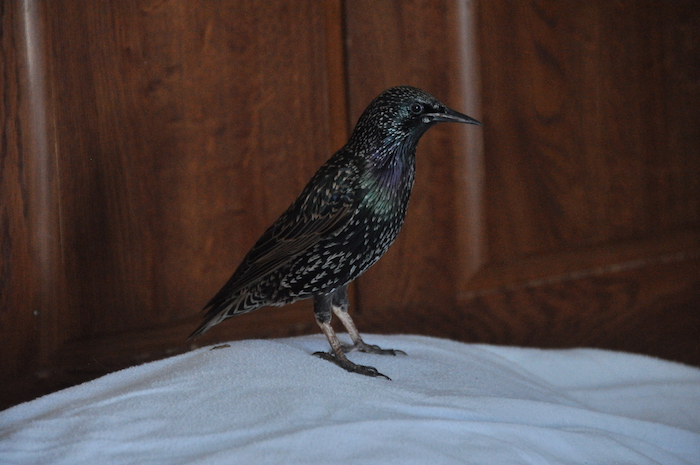
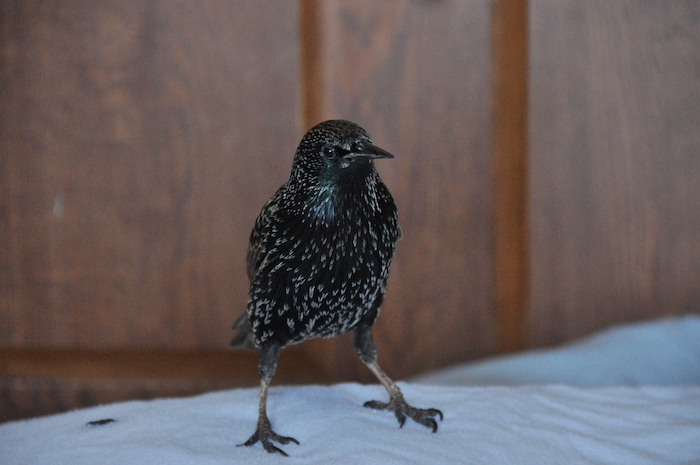
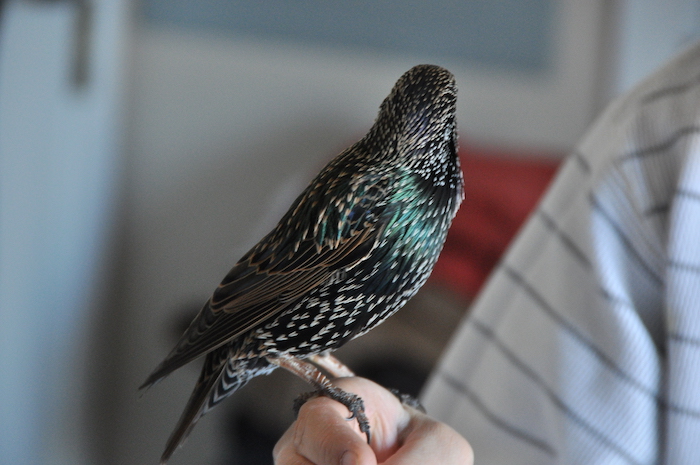
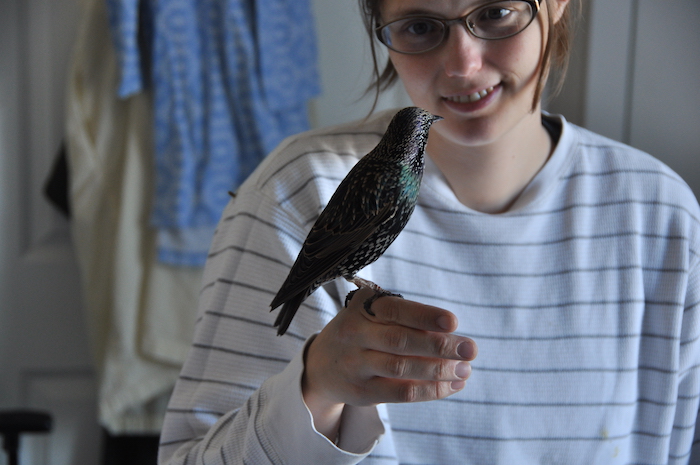
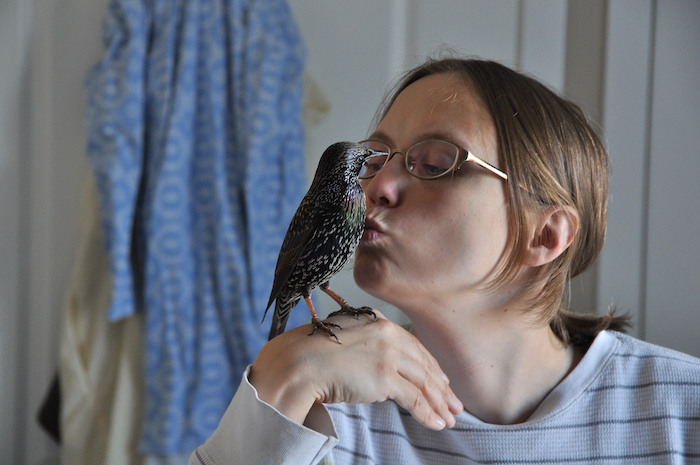
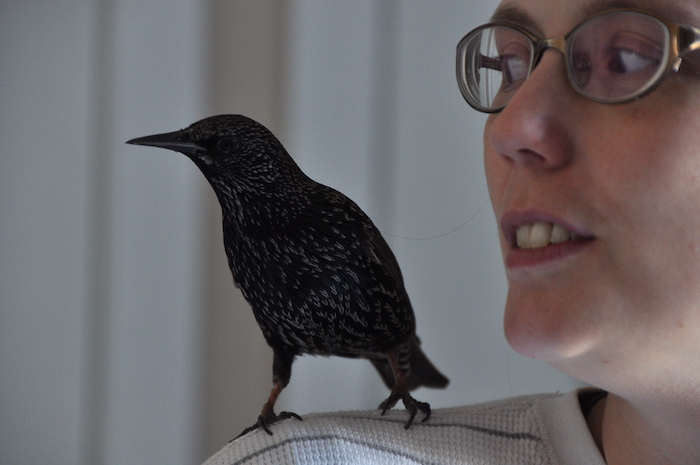
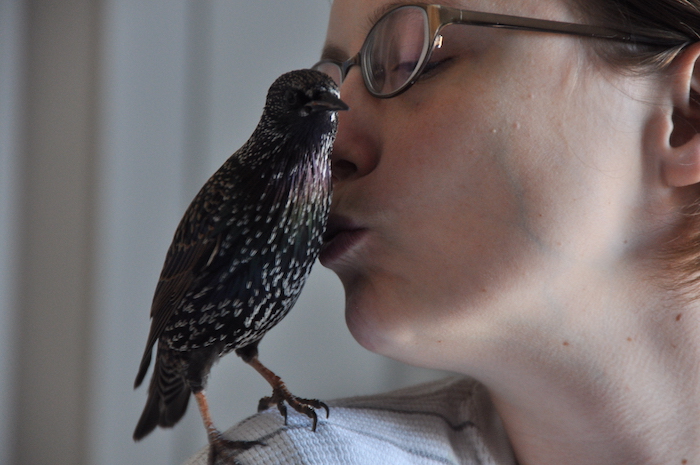

Sirius talks, sings, and plays piano
2015/02/21
A couple cute little videos of Sirius the Starling.
Here he is playing his toy piano with great enthusiasm, while John designs D and D characters with a friend in the background.
And here he is chattering along while John and I watched a Chinese opera. At about 48 seconds in, he really gets going. Most of his vocalizations are still mumbly baby-talk, but the occasional "Pretty" or "Birdy" is quite clear.

Sirius the Artist
2015/02/28
Lately I've been trying to teach Sirius to draw.
It's harder with a starling than a parrot. Parrots are made to hold things in their feet, and once you've gotten a parrot to grasp a pen, it's easy convincing him to move it against a sheet of paper for a while. But starling feet can't really hold anything except the branch the bird is perched on.
First I had to make flat holders for little crayon pieces, big enough for his beak to grasp, but light enough for him to lift and move easily. Then came the task of presenting him with a crayon-holder and rewarding him whenever his beak touched it in any way at all. Gradually I've worked my way up to giving him a special treat when he holds the thing on his own for a few seconds. Some day in the future, I may be able to get him to hold it and then mash it down on a piece of paper, in the same way he attacks a bug or a blueberry, creating a few artistic strokes of color in the process of shaking it to death.
It certainly won't be great art. It'll be barely a scribble, and somewhat less satisfying for the fact that the bird didn't come up with the idea on his own. People looking at Siri's drawings may experience some of the disappointment they felt when they saw that online video of an elephant making a detailed painting of an elephant, only to find out later that elephants NEVER paint a realistic picture unless they are rigorously trained to paint that specific thing.
Now, I am not equating Siri's artistic career to that of the elephant in the video. From what I've heard, those elephants are treated terribly, beaten and gouged every time they draw a line the wrong way. I don't do punishment. I train exclusively with positive reinforcement. Siri gets plenty of healthy food every day (the recommended mix of dog food and poultry mash, with applesauce on the side), but if he does a trick I've taught him, he immediately gets dried flies and other special treats he wouldn't otherwise have. If he disobeys me, nothing happens; I just don't give him a treat.
There are many reasons why I don't use punishment or negative reinforcement. I don't like making any living creature unhappy. And I don't think it would work well, either. Some animals just don't understand it. Truth be told, I didn't understand it in my own childhood. Punishment didn't work on me. I always saw it as an attack that deserved retaliation, instead of a consequence to be avoided by changing my behavior. Whenever it happened, it poisoned the relationship between me and the people teaching me, instead of making it the enjoyable social interaction it should have been.
Positive reinforcement works. It's the process behind Siri's progress on the piano, from showing zero interest in that silly toy, all the way to elaborate recitals like this:
And yes, it may be disappointing, in a way, that he didn't come up with it on his own. But, at this point in time, it's worth remembering that he enjoys it enough to do it on his own. When he's craving attention and treats, he will spontaneously fly to his piano and start playing, without my having to initiate anything.
Yes, he's doing it in order to get something... but that whole process of playing piano, getting a treat, then playing some more, is fun enough for him that he deliberately chooses to begin it.
I think training can be a great part of life with a pet, enjoyable for both human and animal. I've known this ever since I was a child teaching tricks to the family dogs, and whatever other creatures found their way into our home. We took in a lot of unusual stray animals over the years; our house seemed to attract them somehow. Once we even found a guinea pig under some bushes in the backyard. After we brought it inside and fed it, my first reaction was to teach it to shake hands.
It was a very young and cute black-furred guinea pig, very friendly and eager to please, if pleasing me meant that I would give it carrot sticks. This creature would do anything for carrot sticks. So I held a piece of carrot in its face, letting it sniff and nose at the morsel, but holding on tightly, not letting it have a bite until it actually started to paw at my hand. I rewarded each touch of the paw with a carrot bite, until the guinea pig had begun to associate the treats with the action, and soon it was putting its paw in my hand every time I reached out to it.
My parents didn't let me keep the guinea pig; we had enough pets already at the time, so they gave it to a family they knew. It wasn't a family of close friends, just casual acquaintances, so I never saw it again... but I'm told that it lived for ten more years, which is ridiculously old for a guinea pig.
I'm certainly not claiming that this long lifespan was due to learning how to shake hands. But I do believe that learning tricks is healthy for pets, and fills a void they may have inside them, left over from their wild ancestors.
If there's one thing most pets are in great need of, it's mental stimulation. They live in an environment where predators are unheard of, and food and shelter are given to them with no effort on their part. Certainly it's less stressful than life in the wild, and most pets don't want to leave this safe haven. But one can't deny that it gets a little boring after a while.
Animal minds, including ours, are made for a world where they're facing constant challenges in order to stay alive. Of course most of us, human and animal, will choose a safer alternative if we can get it. But in order to stay happy in that safety, we need hobbies and games to challenge our minds.
I believe that learning tricks is one of the greatest games that pets can get to play. It's a combination of engaging mental challenges, snacks, and social time with the humans they love. In fact, it's so fun that it could even be translated into an enjoyable game for our own intellectually advanced species.
Imagine playing with a friend: you are the trainer, and he is the trainee. You have a task that you want him to do (arrange all the pencils in order of color, or walk in a square three times, or wave a feather-duster at the television; be creative and make up something weird) but you can't use language to communicate it.
Your only way to tell him what you want is to give a specific reaction when he gets part of it right. He moves randomly around, doing random things to get your attention, and if he happens to touch the pile of colored pencils, you say "Good!"
He pays more attention to the pencils, moving them around. You say "Good" again when he gets two of them parallel to each other, then again when he happens to get a couple of them in order of color, and so on. See how complex a task you can teach without any words except that one little expression of praise. It's like a cross between "Charades" and "Warmer, Colder." It's fun!
I think Sirius enjoys his piano lessons and drawing classes, and not just because he gets dried bugs to eat. The strongest proof I have is a certain thing he does from time to time. In fact, he did it just now, while I was typing an earlier paragraph.
He flew to his piano, and played several notes. I poured him a little pile of flies next to my computer, and he came and ate a few. But before finishing, he flew back to the piano, leaving flies uneaten. He played some more notes... and then, without me doing anything, he returned to the pile of flies and rewarded himself.
If he were only doing it for the treats, wouldn't he just have stayed and finished the flies at his leisure? I believe that the give-and-take of playing, eating and playing again--- the pattern of the game--- fascinates him on some deep level, and he enjoys it for itself, as a whole.
Maybe some day we'll be able to say the same about drawing.

Sirius mumbling and cuddling
2015/04/20
Sirius the starlingis really cute when he snuggles against my neck and mumbles sweet baby talk in my ear.

Some pretty Sirius the Starling pictures
2015/07/04
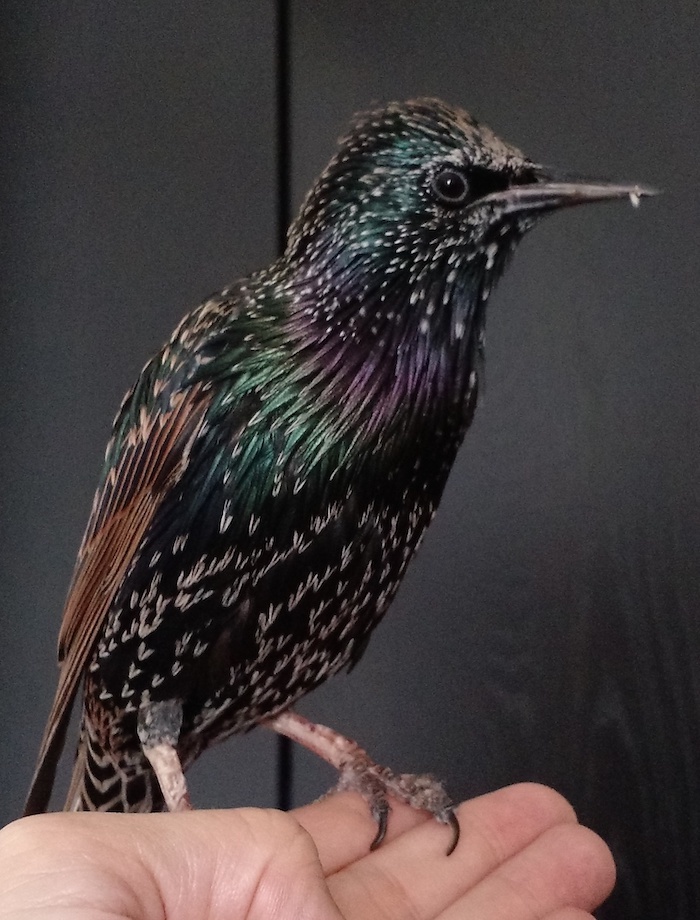
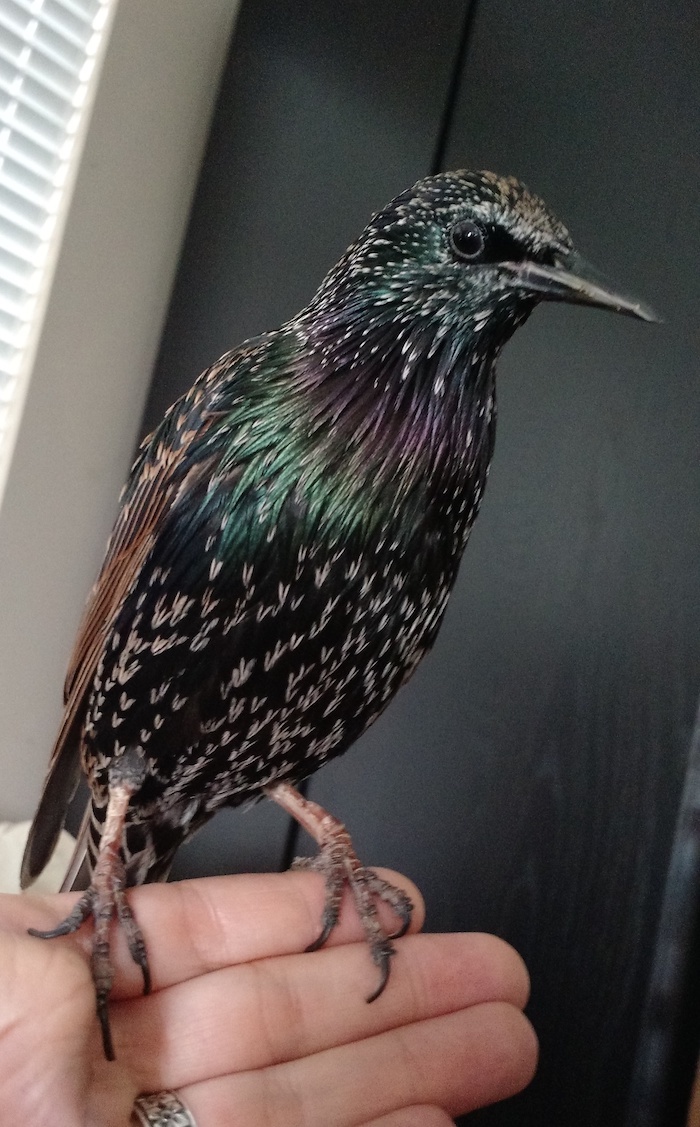
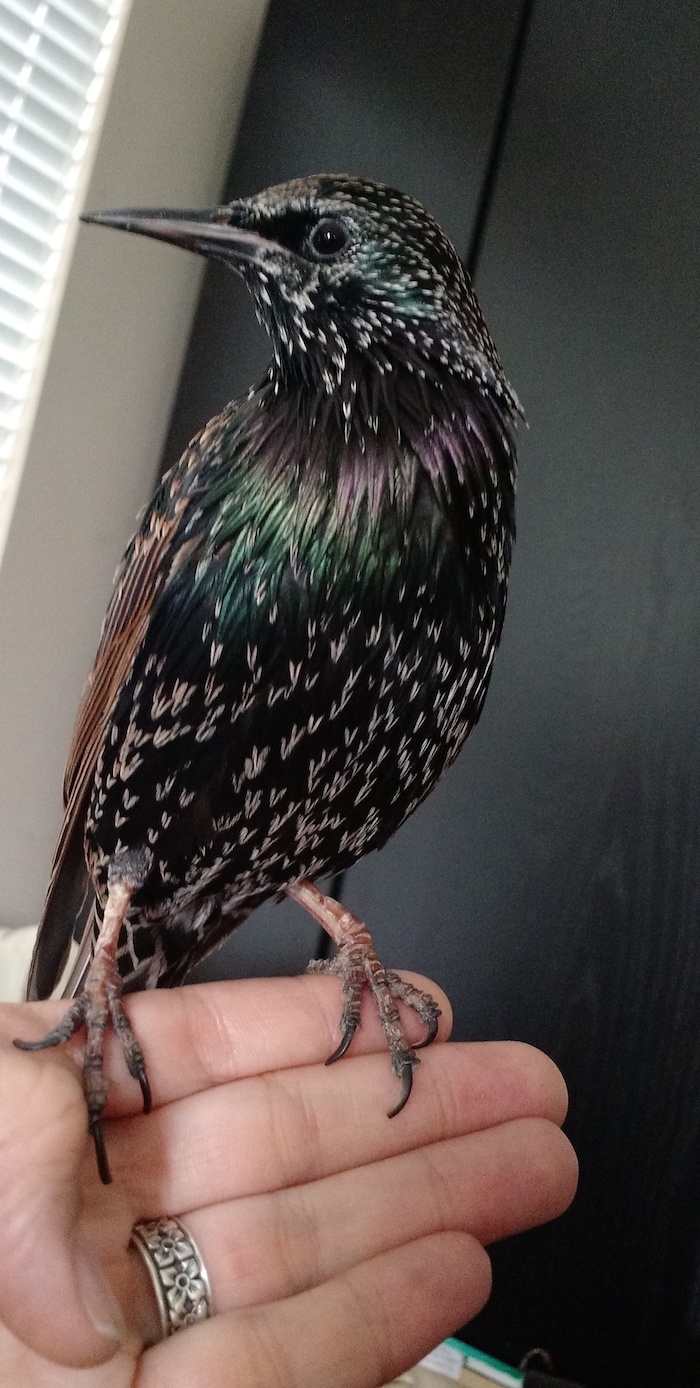
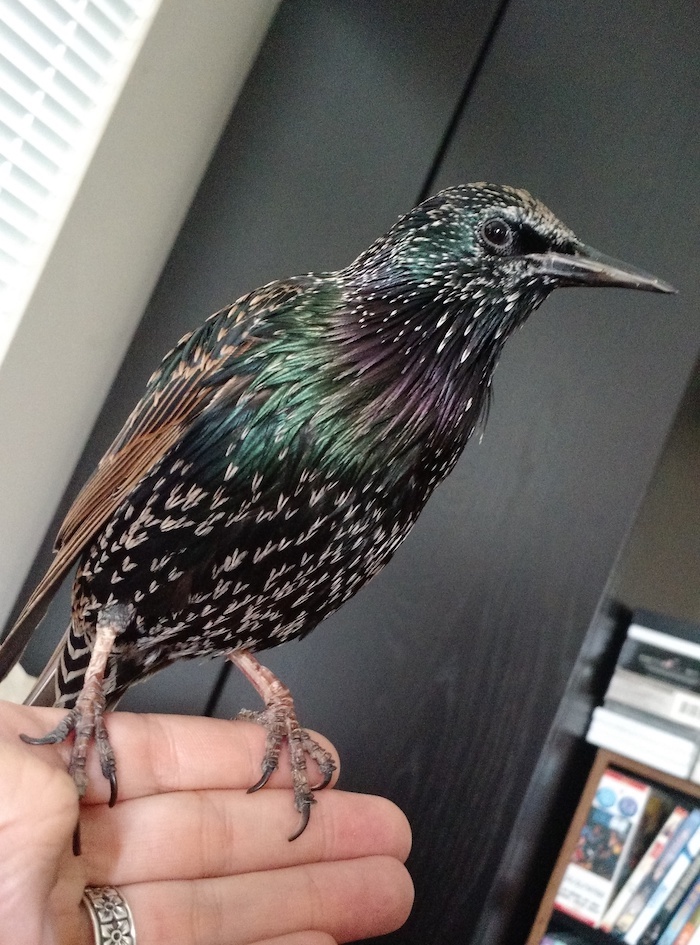
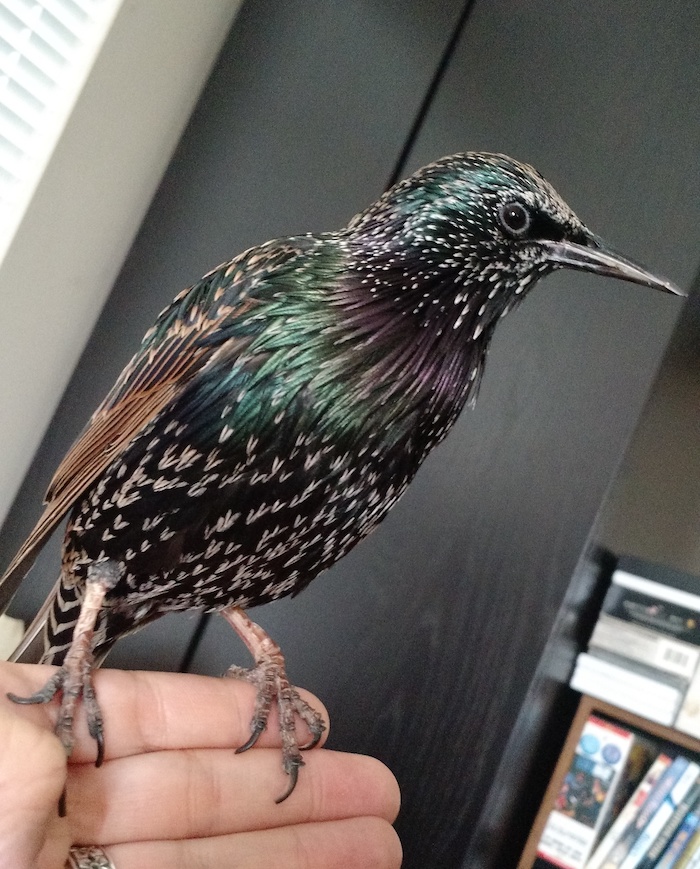
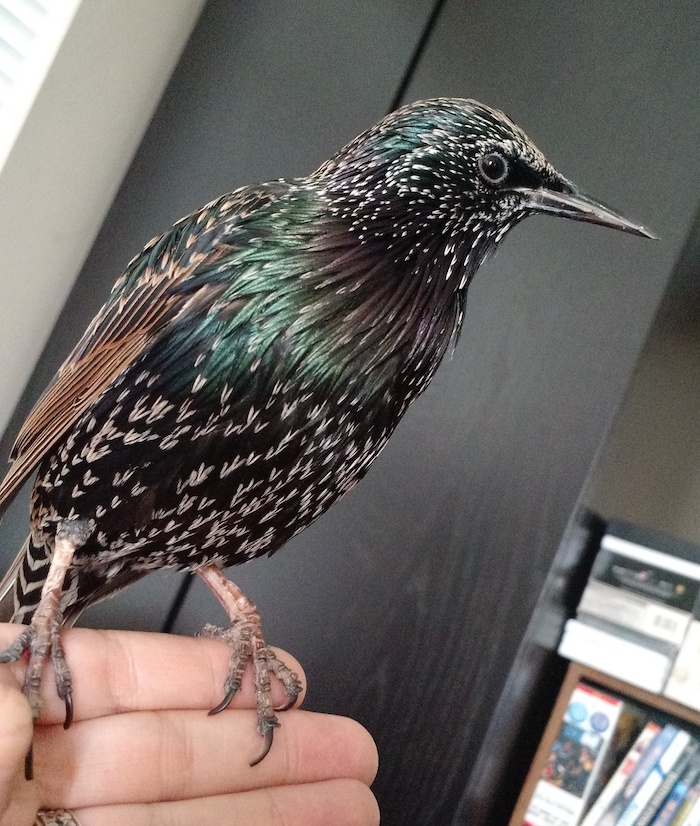
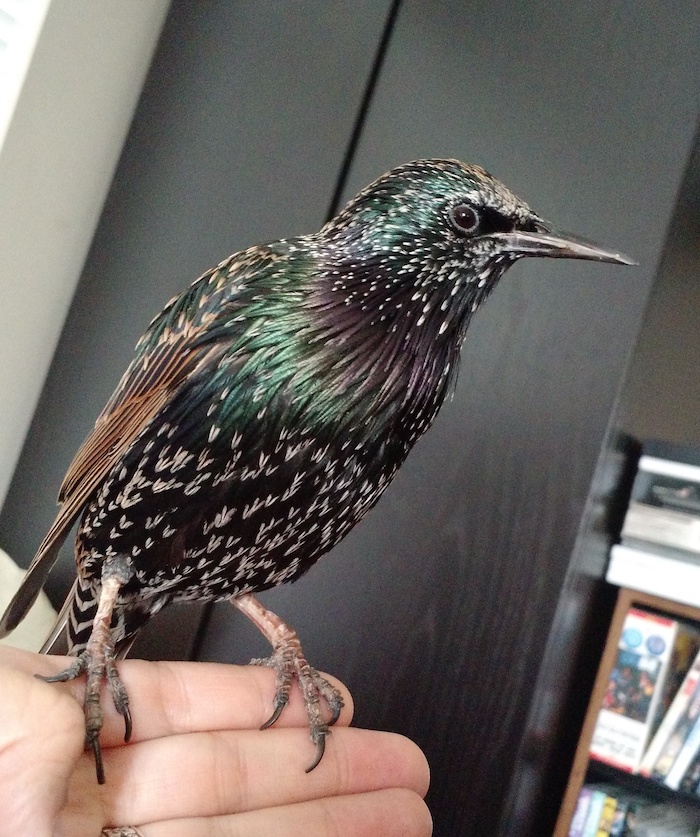
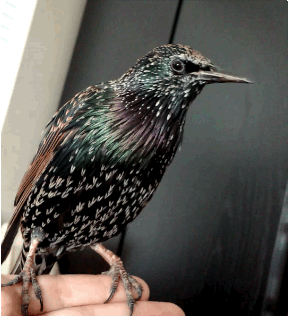
He was looking very shiny.

Took a few videos of Sirius the Starling.
2015/07/04

Sirius the starling is cuddly sometimes.
2015/08/11


Dreams for the future
2015/10/17
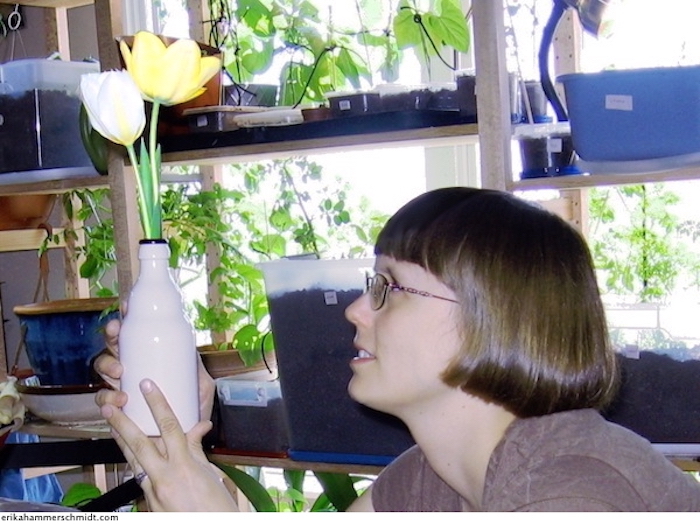

Here is one of my current fantasies, which I'm writing down mostly so I'll be able to remember every detail of it years from now, if the time ever actually comes when I can put it into action.
Basically, John is hoping that someday he can get a comfortably-paying job that lets him work from home, and in the fields he's studying, that's somewhat a possibility. And we may soon be in a position to put a lot of money in savings (if we can sell the condo before another dismal housing market crash happens...) Anyway, we have a dream about what we'll do if we, somehow, manage to become totally financially stable.
It involves buying a piece of not-very-developed land, not too far outside a city somewhere, and setting it up with wind and solar power, and a fair chunk of space to grow our own food... living somewhat off the grid.
And we would make part of it into some sort of attraction for local people. We got the idea from this awesome hobby-farm/petting-zoo/mini-golf-course near Minneapolis:
https://bigstoneminigolf.com/(warning: horrendous flash site, with embedded music and everything. But great place to go in person.)
John and I have somewhat different dreams after that point. John wants to have a horse. I'm fine with pretty much anything as long as we can have wind and solar power AND a Monolithic Dome Home. I am praying that Monolithic is still in business by the time we can afford one, because these ultra-energy-efficient, ultra-long-lasting, friggin-tornado-proof miracles are an absolute object of worship for me.
https://www.monolithic.org/
Anyway, the following is what I fantasized about today. I thought of it because of our amazing pet, Sirius the Starling:
https://www.erikahammerschmidt.com/2014/06/15/a-year-of-sirius-marley-black-starlings-in-review/
...and how, even though he is a totally ordinary bird by ecological standards, one of the most common, overpopulated pest species on our continent, visitors to our home STILL act as if they are witnessing some amazing zoological wonder whenever they get to see him and hold him.
Granted, he IS pretty awesome. He can sing. And talk.
And play the piano.
So the feeling is somewhat justified.
But anyway, I was thinking about how even a common bird, or other small animal, can be a kind of wondrous and fascinating thing, to people who aren't used to seeing any animal besides a dog or cat up close.
And I got the idea for the Bird Garden.
I want to have two Monolithic Domes.
One, we will live in.
The other will be a shelter for "pest birds," the invasive bird species that aren't protected by law, that most states allow people to kill, capture, and keep as pets, but that wildlife shelters often won't take.
Common starlings. House sparrows. Rock pigeons. If you find one orphaned or injured, bring it to us. If you must have a nest of them removed from your property, give us the babies instead of destroying them.
We won't breed them or release them. (We couldn't, anyway. Most birds raised by humans consider themselves humans, and don't even want to fly away and live as birds, or mate with their own kind.) They will live out their lives in the Bird Dome, an educational and entertaining attraction.
It will have a tiled floor, several big windows (with shutters in case of bad storms) and plant-friendly electric lighting as well. It will be FULL of potted plants. Everything from flowers and vegetables to trees, as long as they're bird-safe. And statues and sculptures and fountains. It will be like an enchanted fairyland.
Except the fairies will be birds.
There will be plenty of hiding places for them in case they want to be alone, but if they want company (probably human company, since they'll be mostly human-raised and human-imprinted) I will spend virtually all my time in there. If I can't, I will hire people to spend time with them when I can't be there.
And whoever is there looking after them, will also get to be a tour guide. People from the city who want the experience of being surrounded by tame birds, they can come visit any time, for a tiny entry fee and hand-stamp that lets them stay all day.
They can buy baskets of food to let the birds eat out of their hands. They can peruse my gift shop where I'll sell all the random crafts I make, as well as any bird-related stuff I can think of. They leave with warm feelings in their hearts, and lots of newly-learned facts about birds that I will have shoved into their heads.
And maybe we'll have other animals living in the Bird Garden as well... rats? guinea pigs? lizards? Anything that's fairly easy to care for, fairly friendly, and not very capable of harming a human. I'd have to figure it out. (The Big Stone petting-zoo/mini-golf-course has goats and horses and stuff, and I wonder how they do it without too many instances of customers getting bitten or kicked and suing them. I'm gonna inundate them with emails of praise and advice-seeking, if I can brave their awful website.)
So, that's my fantasy. I know it will cost money and might never make money, and it would be lots of work, and there would be legal things as well as logistical things I'd have to figure out. But, for the moment, I'm finding it incredibly fun to dream about.

Dancin' Around
2015/10/18
My silly starling plays with a hair accessory.

Sirius's new snack
2015/11/04
Hey, remember when I posted about buying bugs from Arbico Organics?
Well, they found that post, and liked it so much they sent me some more treats for Sirius, to say thank you! Another bag of dried flies, and a little canister of dried fly pupae ("Cocoon Capers") which he was delighted to try!
Look at him eat those little things. He's adorable and soooo happy.
I can only reiterate: Arbico Organics is a great company!

Sirius the starling's weird molt
2016/03/24
Sirius the starling has shed a bunch of feathers on the side of his beak... they started to grow in again, but then they were gone. The other side of his beak hasn't done it.
I'm not sure if this is a normal part of the spring molt or not. He hasn't done the full spring change, any of the years since we got him (his beak has never turned yellow) but something is different this year.
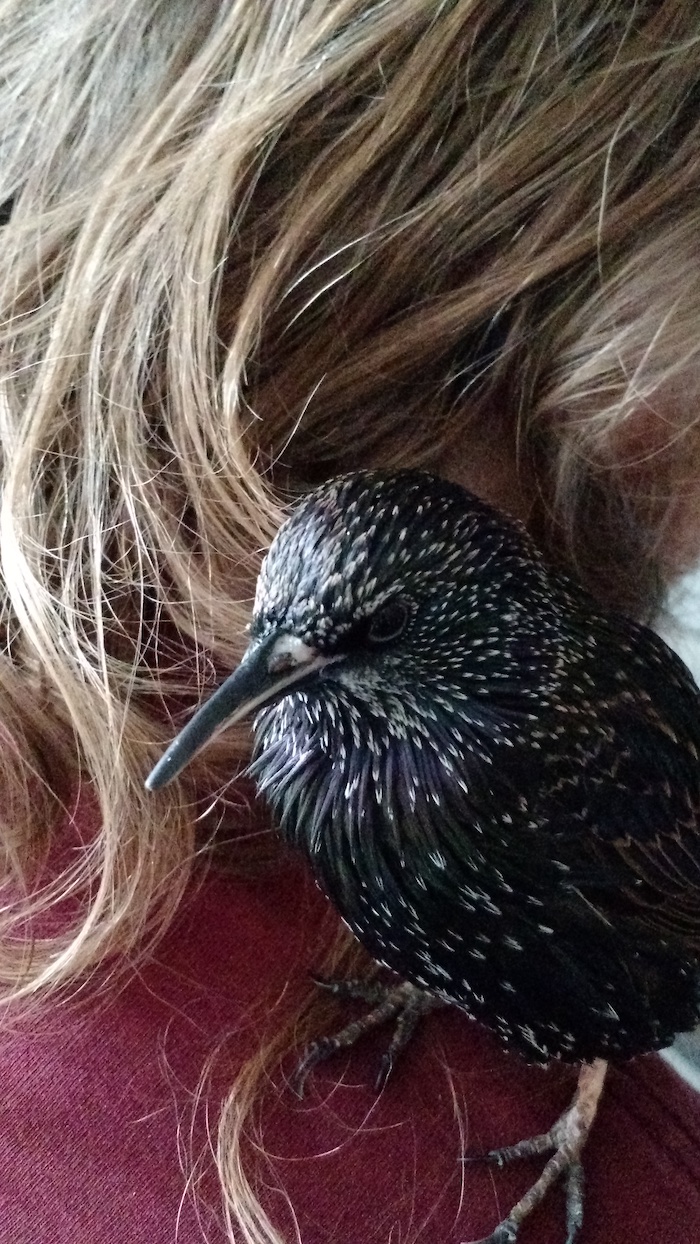
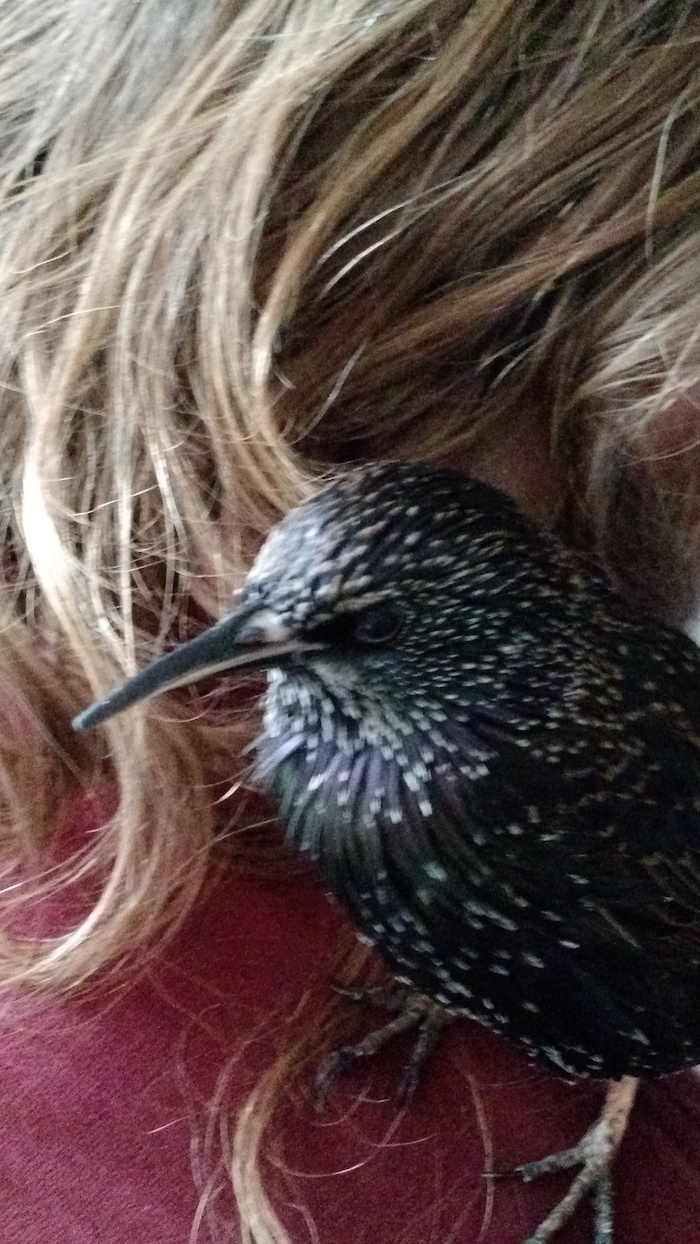
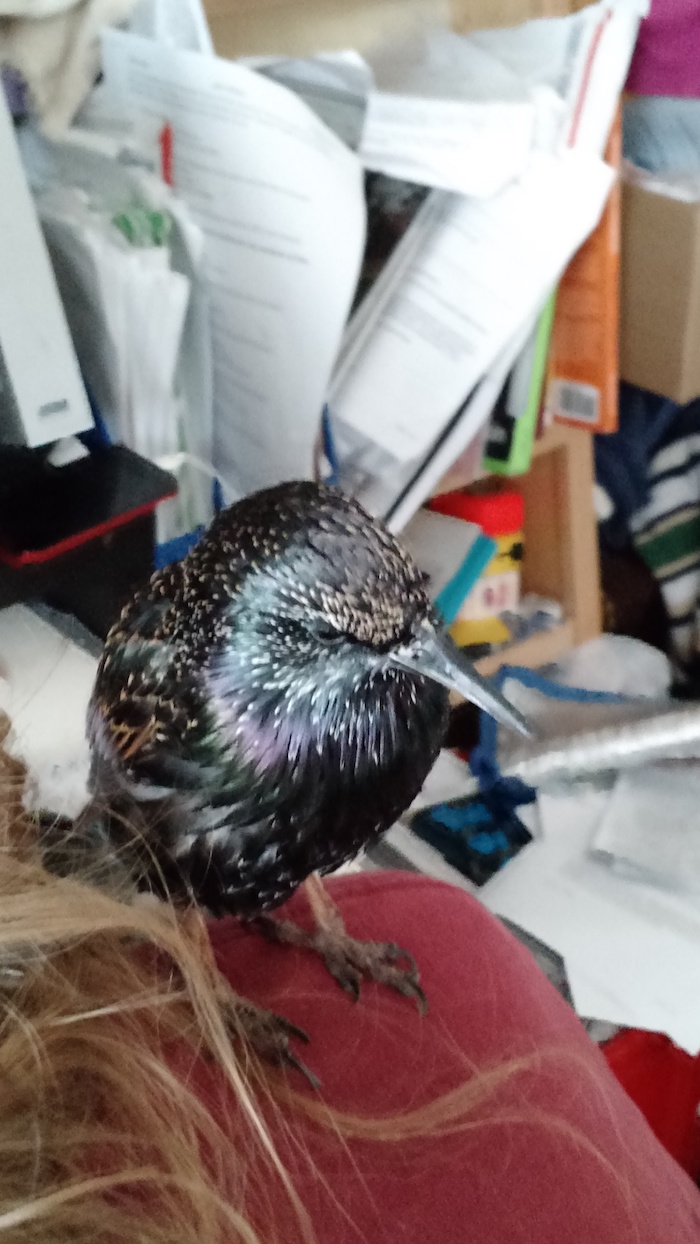

Sirius the starling has a cone
2016/09/16
This bird will make my hair gray.
He's been scratching at a spot on his face for a long time, so much that the feathers fell out... and now he's scratched so much it started to bleed. A lot.
I've put some DMSO anesthetic on the scratch, hoping it will reduce his desire to pick at it, and we improvised a cone out of paper and gauze. He's frustrated that he can't preen, but so far it seems to have stopped the bleeding.
Keep us in your thoughts. Thank goodness this at least happened on a Friday night, so we have the weekend to deal with it...
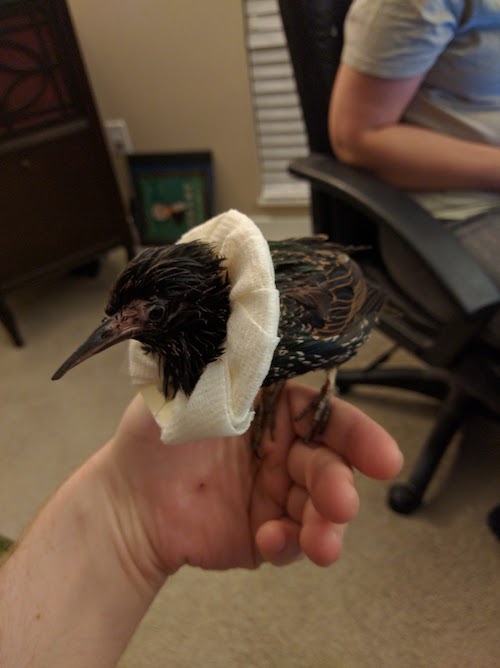
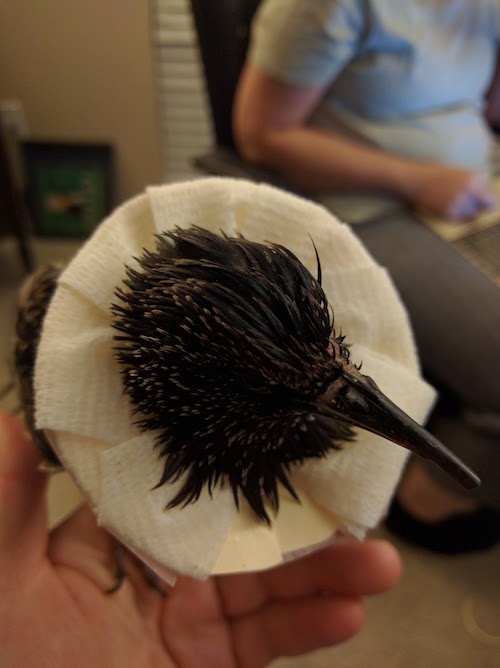

(no title)
2016/09/29
My bird sat on my arm so long he left footprints.

Counting blessings
2016/11/27
In the spirit of Thanksgiving, and to take a positive turn from the many negative thoughts I've been having lately, I'm going to make some posts this week of things I am happy about.
To start with: Sirius the Starling has been getting better. His face injury has healed and his feathers are coming back in, little by little.
Here are some pictures of him hanging out on my hand and eating crickets.
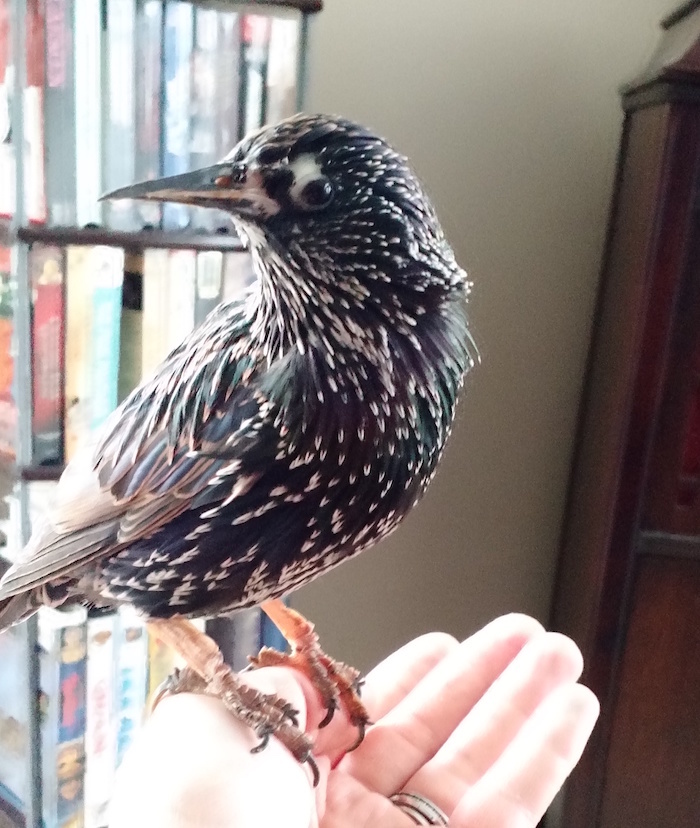
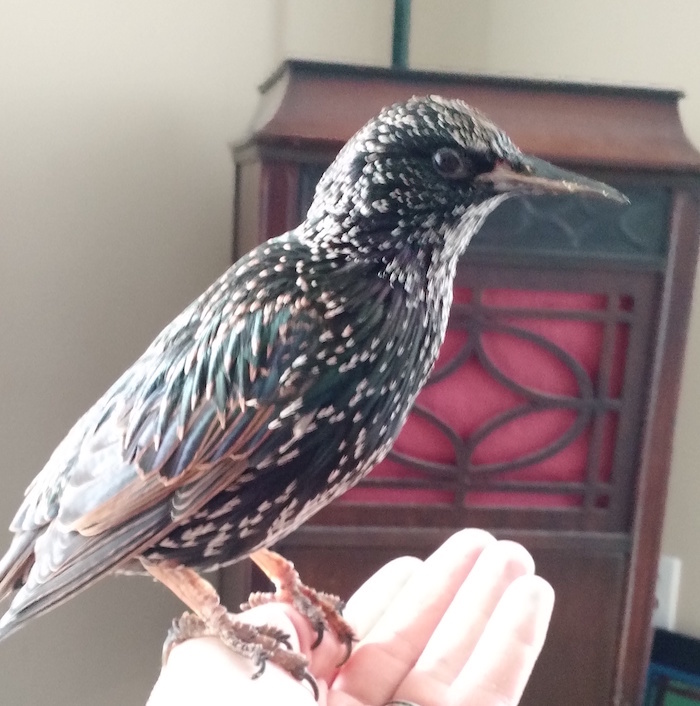
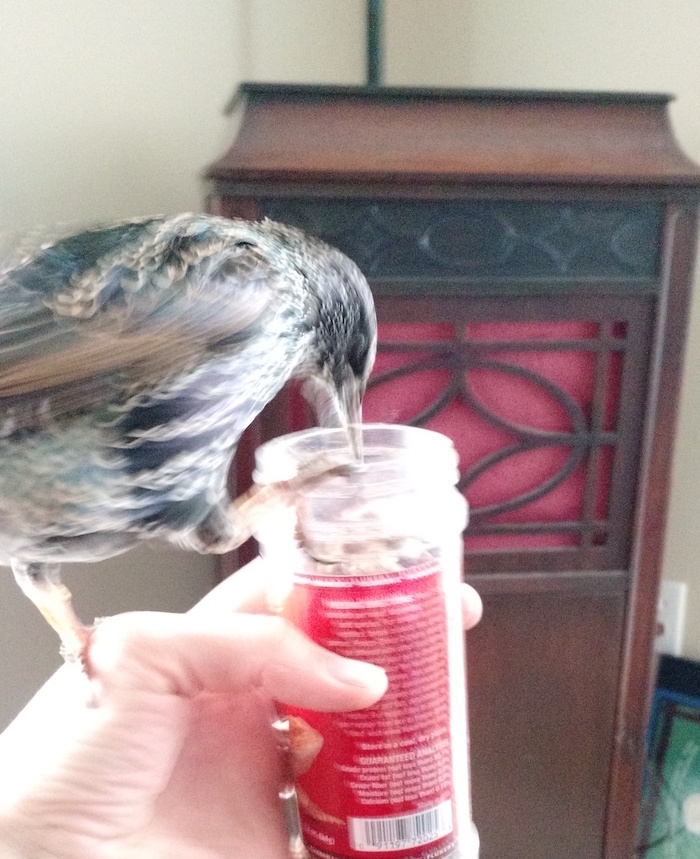
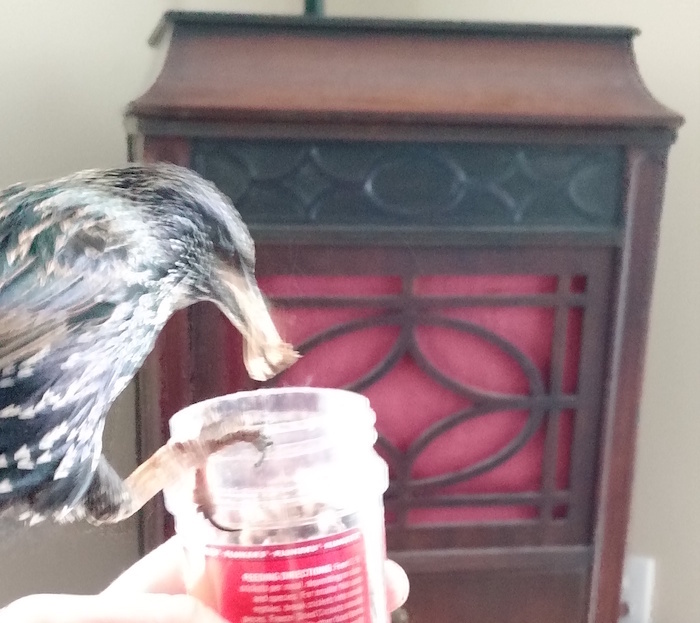
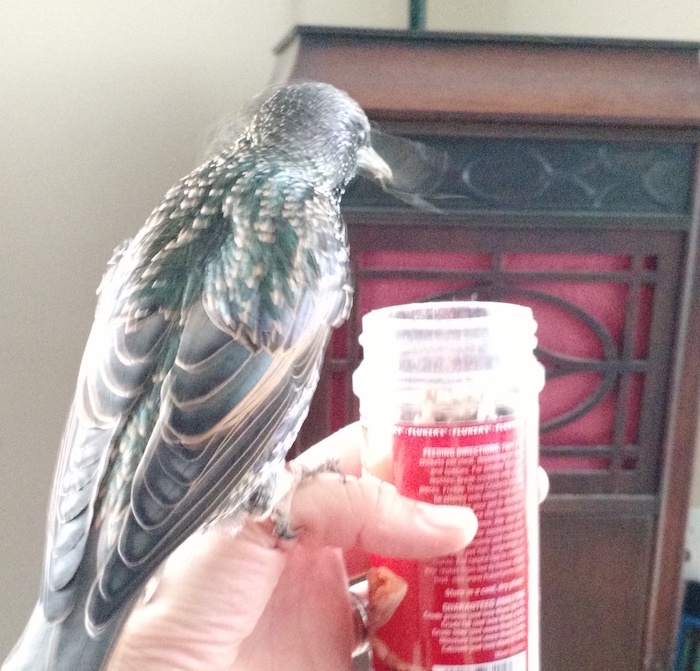
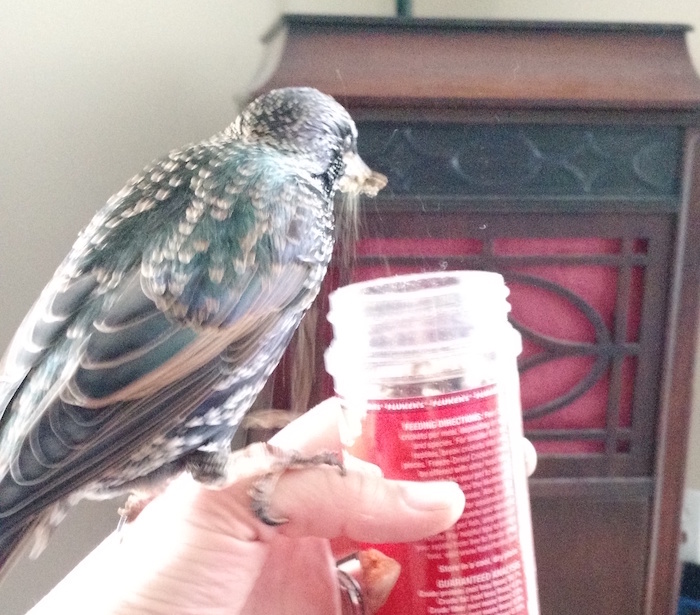
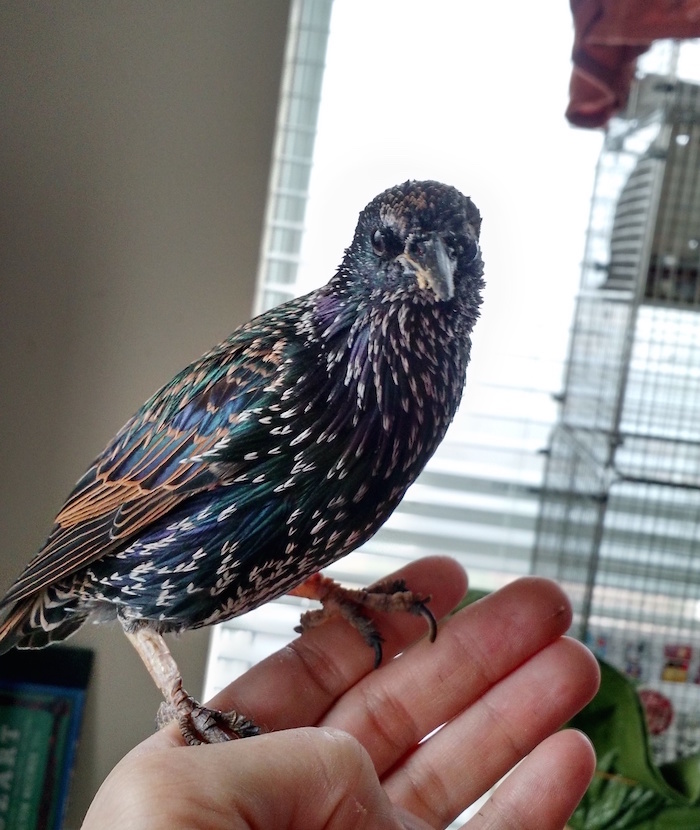
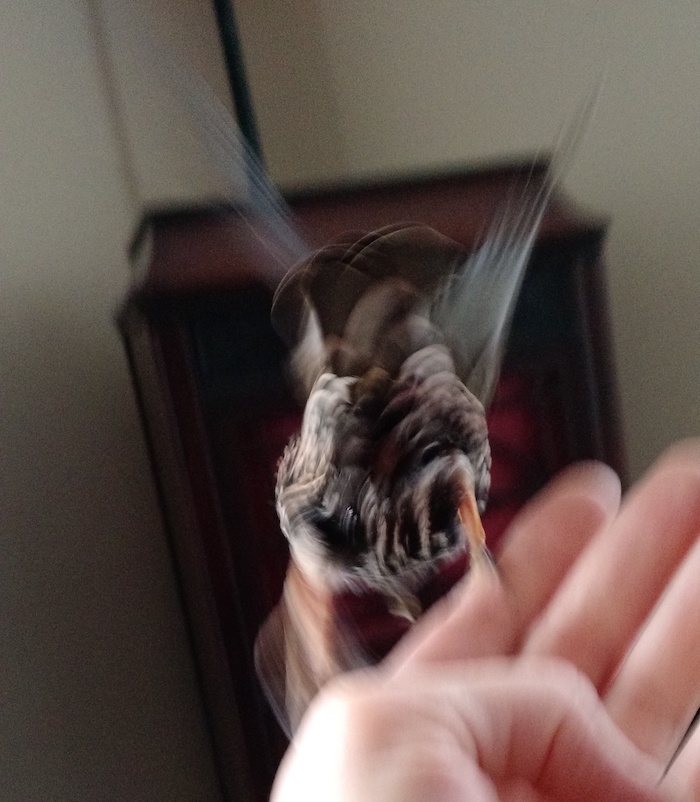
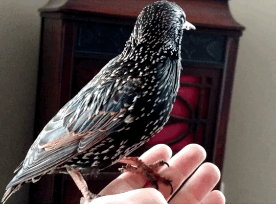
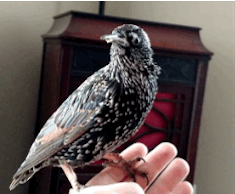

Counting blessings, 2
2016/11/29
Oh, and another thing I'm happy about, although I don't have pictures of it yet:
I have a bunch of my handmade jewelry in the Music Forest Cafe ! It's this really charming little vegan cafe in St Paul, and it has a section with locally made crafts for sale, and my stuff is there!
And I am happy about that. I'll get some pictures of my pieces on display when I stop in this weekend.
Oh, and John and I gave a speech in Marshall, MN last week. It went great! We do have a pic from that. Not a very interesting picture, but here it is:

It was a pretty typical speech, except for one thing. Because it was so far away from home, we had to stay the night at John's parents' house in a nearby town... and because our roommate has moved out, we couldn't have him look after the bird while we traveled.
So we had to bring Sirius the Starling on a road trip!
John made the weirdest-looking cage and Siri actually liked it, unlike any other travel cage-- he would willingly go into it, and when he wasn't in it, he was on our shoulders watching the traffic go by, and he had a total blast riding in the car with us! I'm so happy-- he has always hated car rides in the past, but we figured out a way to make it work for him! (Again, pics of the cage coming later.)
And at the speech, we actually brought him in, in his cage, and set him on the counter, way off to the right of that photo. It was so cool; I wish we could do that with more of our speeches!

Sirius and his fluffy feathers
2017/01/21
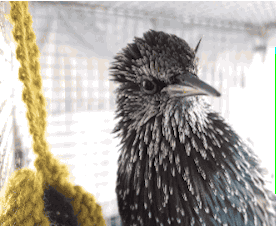
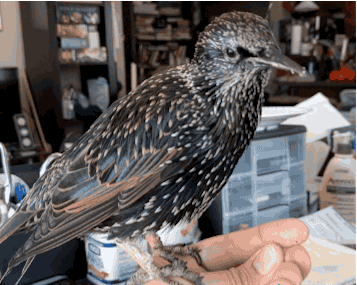
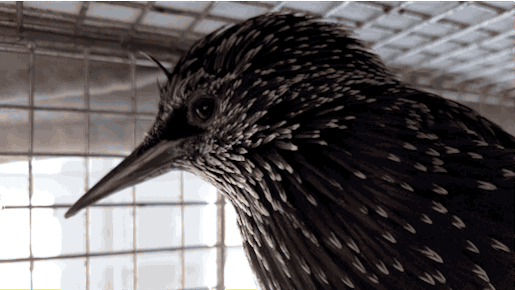
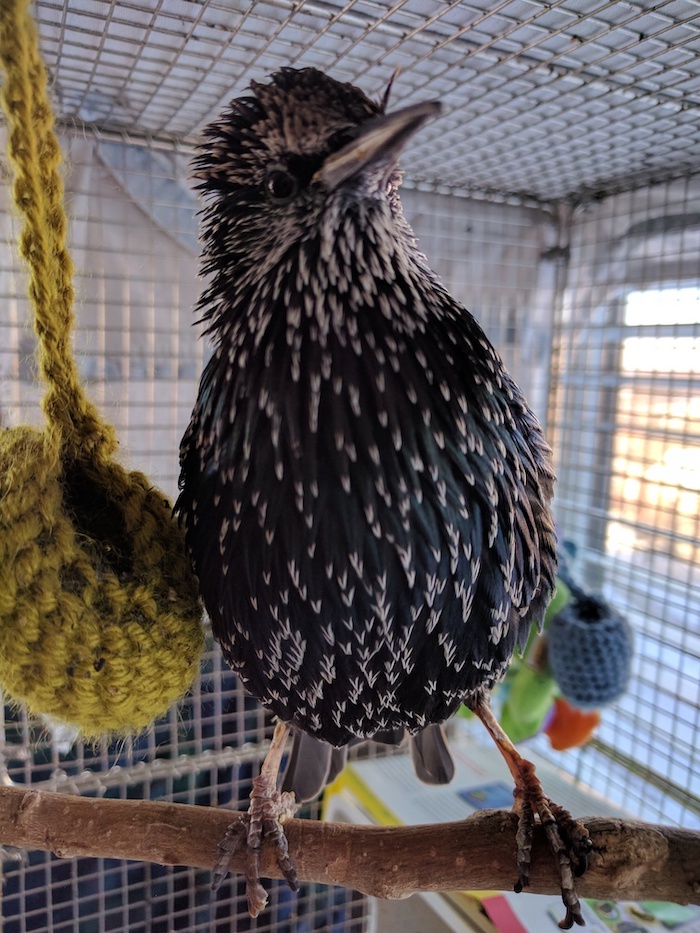 Sirius the starling has grown back all his missing feathers!
Sirius the starling has grown back all his missing feathers!
He still has a few crooked ones, like the feather that sticks up on his head and the one that droops on his tail. But he is very fluffy and pretty today!

Petting Sirius the starling
2017/02/04
Siri isn't crazy about petting, but it's important to keep him accustomed to the touch of hands in case he needs to be handled for emergency reasons.
And once we start petting, he kind of gets into it and starts enjoying it. Until he's done. Then he lets us know.
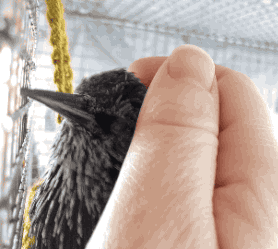
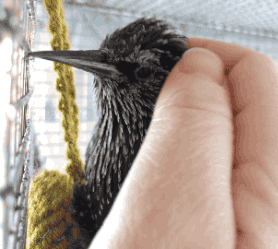
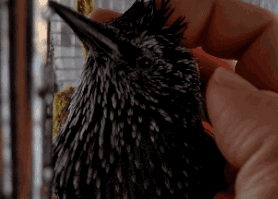
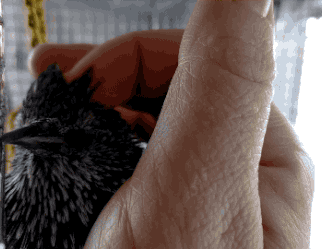

Sirius eating lunch
2017/02/18
He is a ravenous little dinosaur.
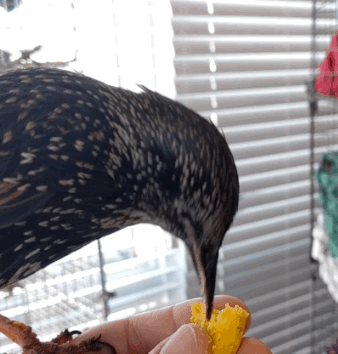
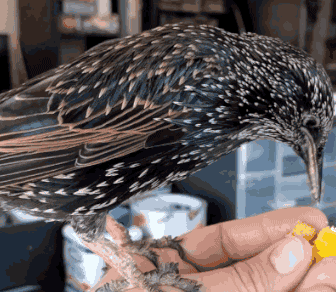
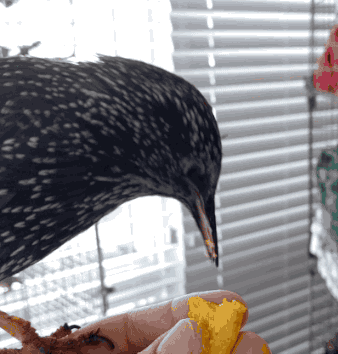
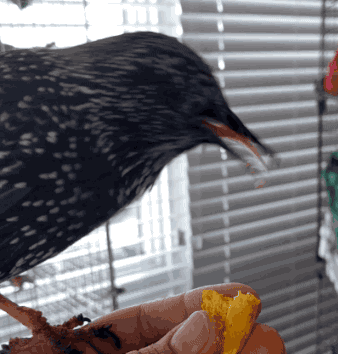
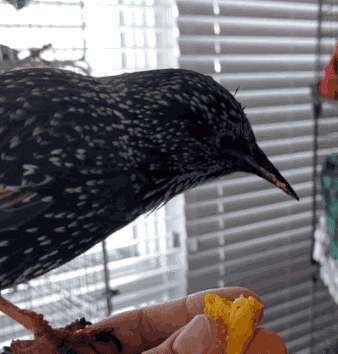
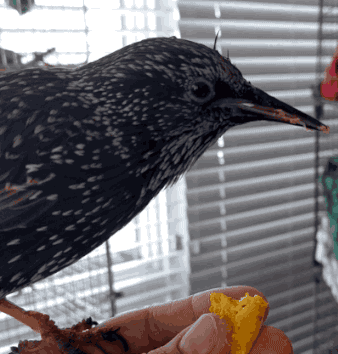

Travel Cage and Vet for Sirius
2017/02/19
Sirius the starling had his first vet visit today!
Details of the vet visit after the pictures. Basically, Siri was very good and he appears to be in good health too, though there are a few mysteries about his health that couldn't quite be solved (vets don't really know a lot about starlings, since they're so rarely kept as pets).
Here are some pictures of Sirius at the vet, in his travel cage, and some pics of the cage by itself. It's not pretty, but it's the only travel cage we've been able to design that Siri seems comfortable in. He's really comfortable in it, too! He's been on a three-hour car ride in it before, and seemed fine!
It's John's design, but easy enough for me, or probably anyone, to build.
It's made of a plastic bin and some black plastic mesh from the hardware store, held together with zip ties. (We know that dowels don't make the best perches, and we're trying to find actual branches that fit well in the holes of this mesh. His regular cage at home is much bigger and has real branch perches.)
The opening is just three cuts in the mesh, with the cut sides covered with plastic from a heavy-duty trash bag (held in place with zip ties) to protect from any sharp edges. The mesh is bendy enough that we didn't need to create a hinge. A small bungee cord holds it shut when needed.
A bigger bungee cord holds the top of the cage onto the plastic bin bottom, and it can be taken off to replace the paper or rearrange the perches and other accessories.
I made a smaller version of this cage, too, with a shoulder-carrying strap, in case I ever need to get him out of the house extra quickly.
Anyway! Here are the pictures:
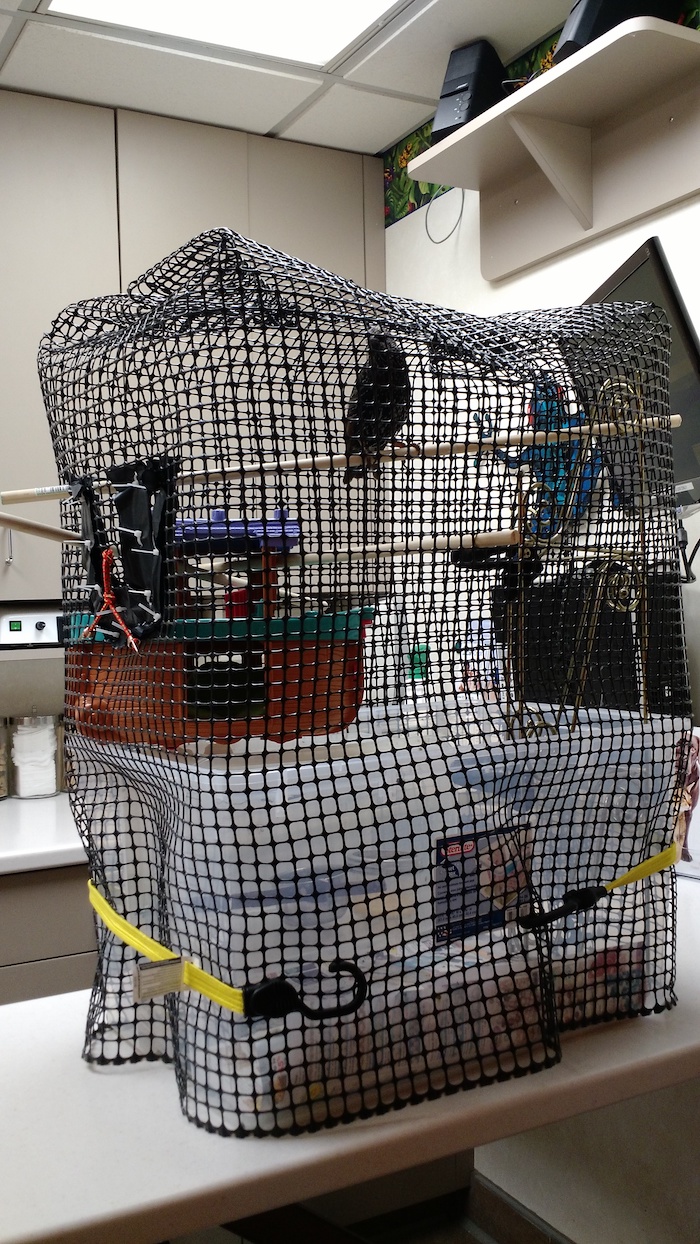
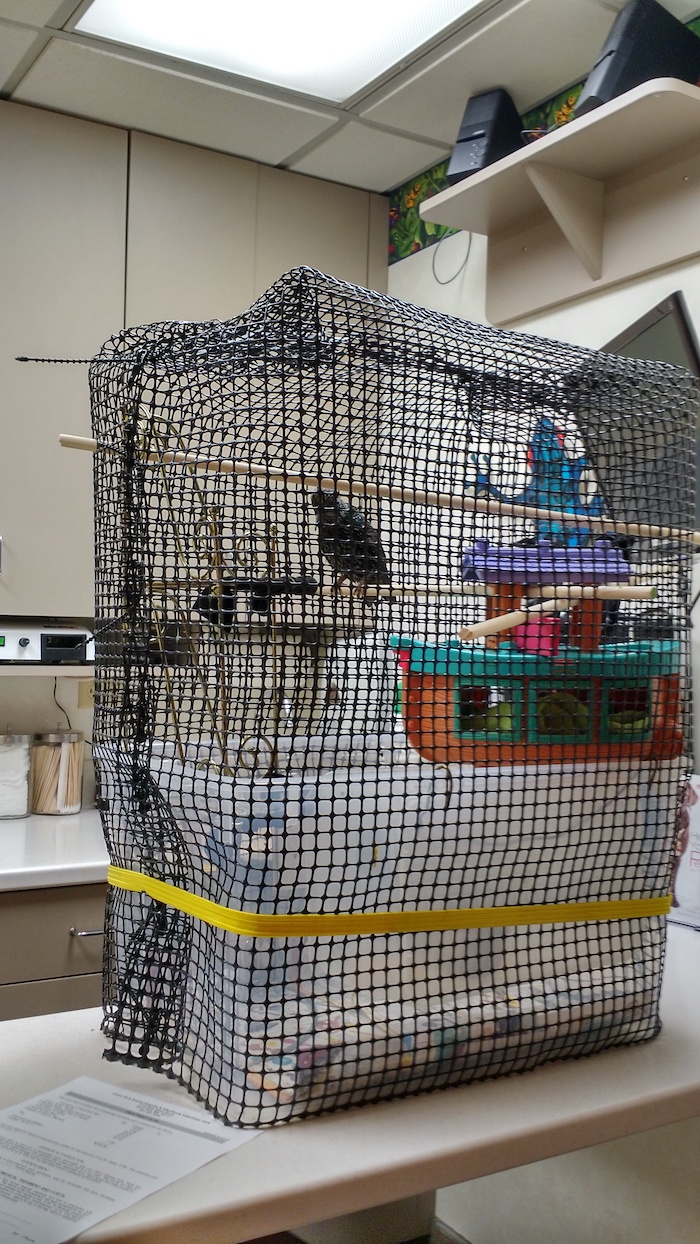
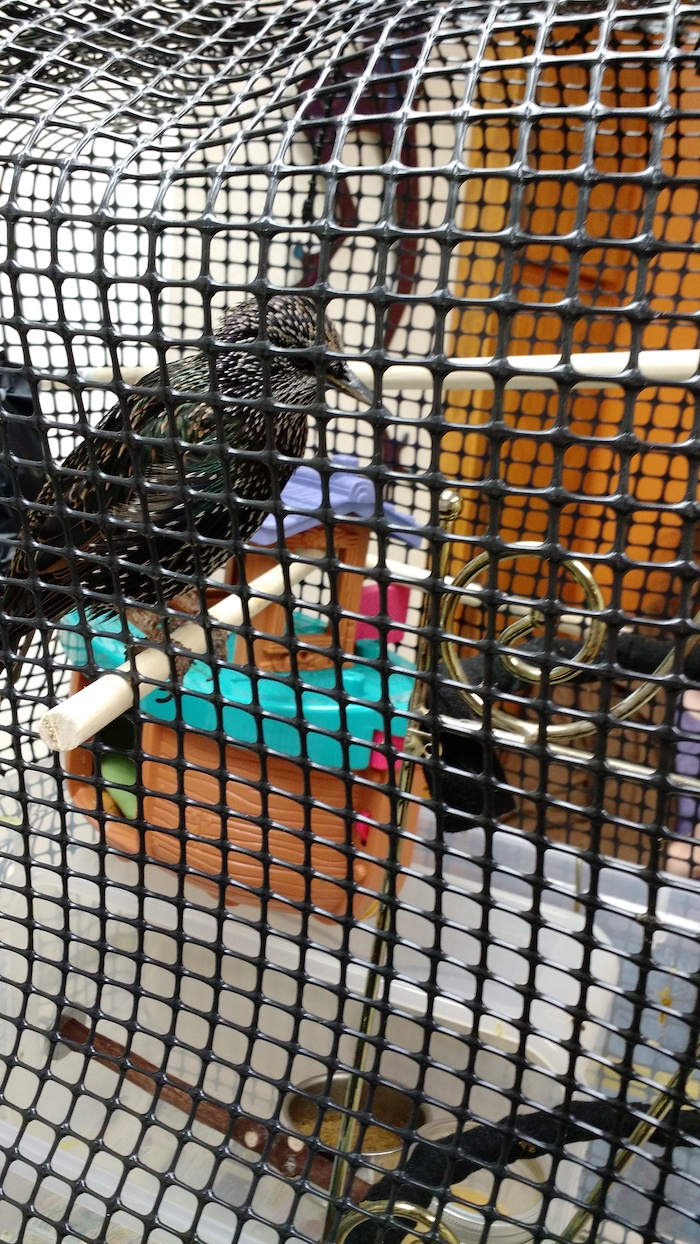
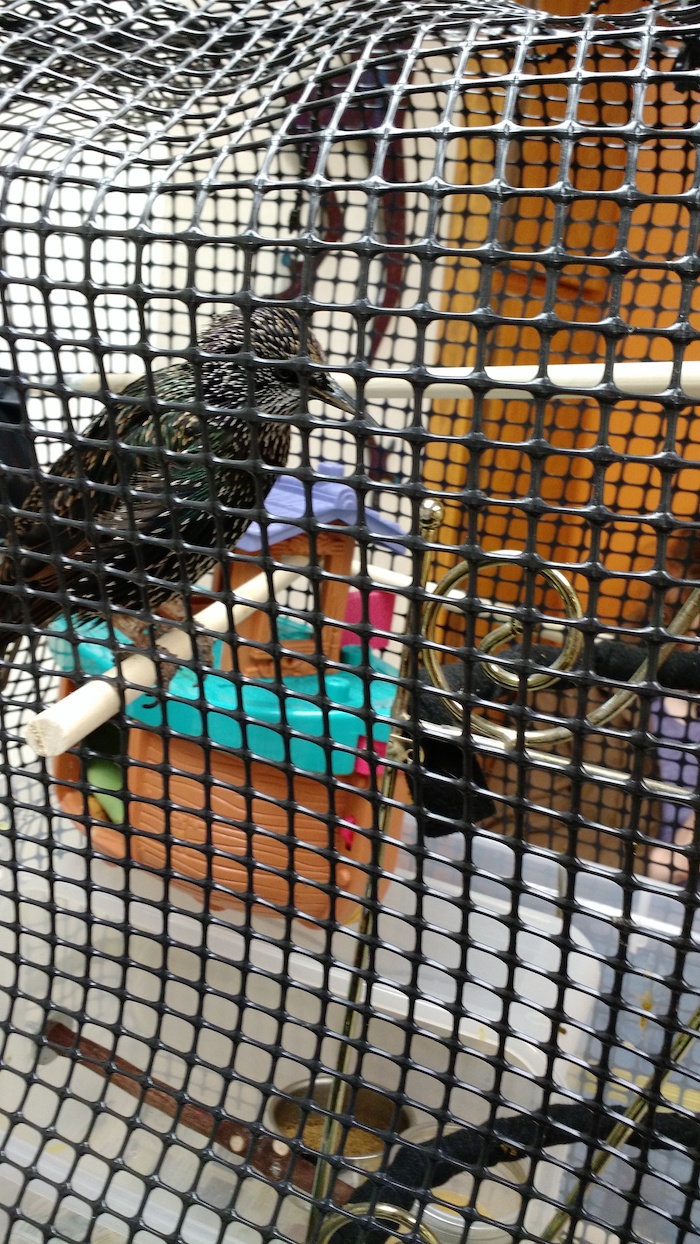
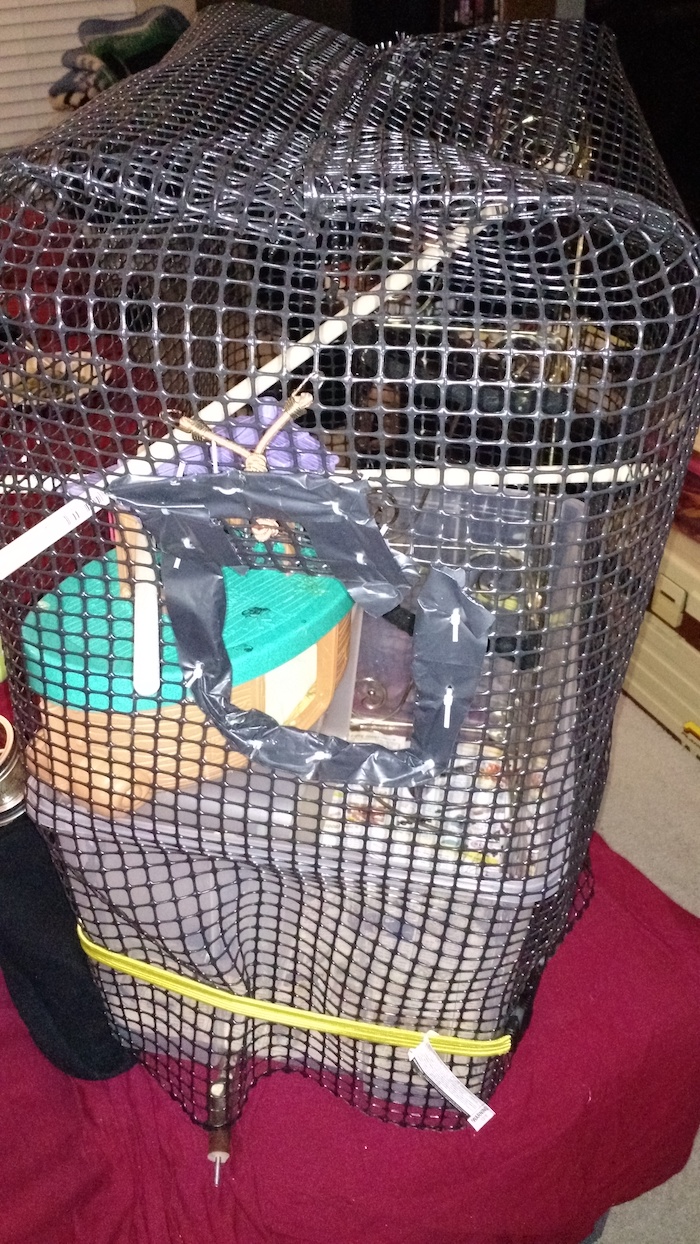
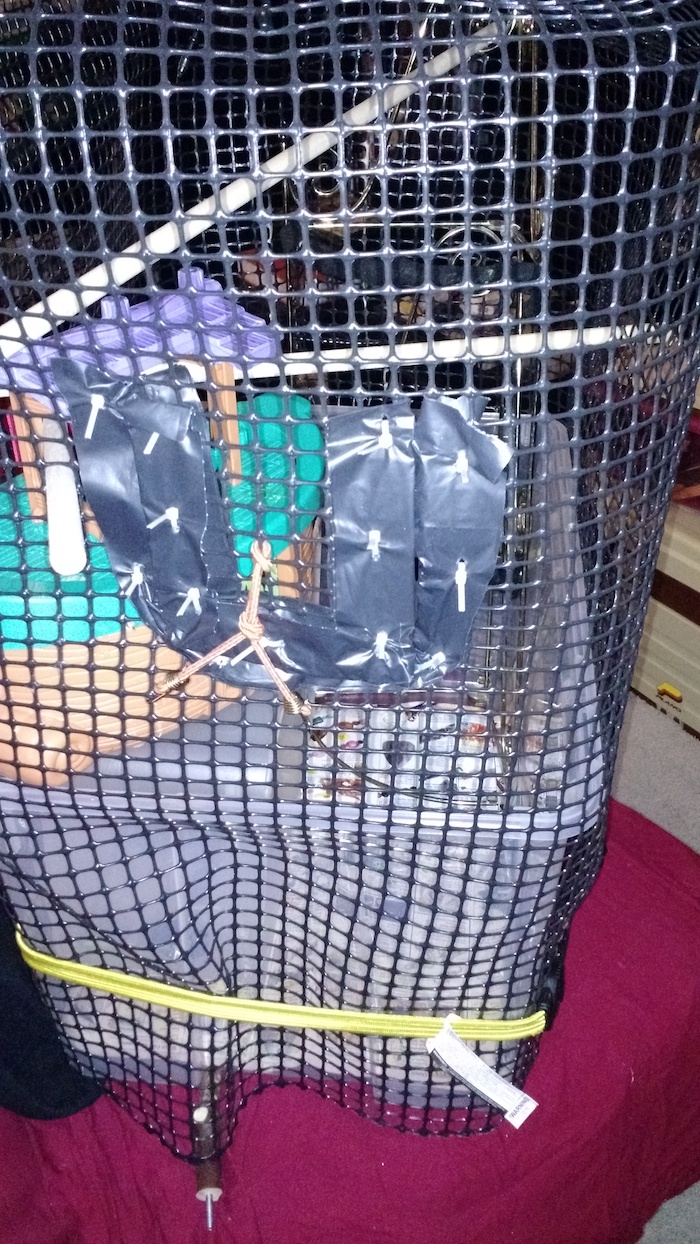
And, in our experience so far, Como Park Animal Hospital in St Paul, MN, is a very nice, very reasonable and very accepting veterinary hospital. Very few vets around here will treat birds of any kind, but these people were totally fine examining a captive-raised starling.
Although Siri didn't show any real signs of being sick-- he's still eating healthily, singing and being active in every way-- we'd been concerned about a swelling on his abdomen and a callus and bruise-like mark on his foot.
And we didn't really get that resolved on this visit, but the vet gave us some reassurance.
After the examination, they said that from the location and texture of the abdominal swelling it looked like a gastrointestinal issue... but since his stools are still normal, and a test for parasites didn't turn up anything, they weren't able to give us any conclusive answer. They did give us some options, though.
We could have an x-ray to see if any problems were visible that way. We decided not to, since an x-ray on a bird requires anesthesia, which gets more risky the smaller the bird is, and if something did show up, it would probably be something we couldn't do anything about anyway. The vet explained these things very honestly and reasonably.
He also said that if the problem gets worse, we could give the bird a deworming medicine just to see if there might be any parasites that didn't show up on the standard test. But since that's not so likely, and since Siri still appears to be in good health, we decided not to do that right away either.
As for the foot, he said it didn't look bad enough to be dangerous, but recommended giving him softer perches, maybe by wrapping them with padding material (I think he was talking about this stuff , since I've found some mentions online of people using that to wrap perches.) He also suggested extra vitamins and maybe more sunlight to help with the few overgrown scales that keep coming back on his feet.
And this all did cost some money, about $130, just to have him examined, tested for parasites, and prescribed a vitamin powder. But honestly I was expecting to pay more; I was scared of having to spend thousands on him, because I've heard so many stories of awfully expensive vet procedures. This vet is reasonably-priced by vet standards, as far as I can tell, and didn't push unnecessary expensive procedures on us. (There was no pressure to do the x-ray, for instance, and if we had chosen to, it would only have been about $40 for the anesthesia and $80 for the x-ray itself.)
And it's good to know that there is a vet in town who's willing to see starlings. And it's good to have a clean bill of health regarding parasites. Overall I think this was well worth doing.

Heartbroken
2017/03/16
It's been a few days but I still don't really want to talk about it. Sirius the Starling has passed away.
When the growth on his belly started, I was preparing myself for the possibility that this could happen, but I did not expect it to get so bad so quickly.
I'm not going to go into all the details because it would make me cry again. Maybe someday. I feel like I failed him, even though there wasn't really anything I could do. I don't think anything that we did caused the problem to start. But we can never know for sure what caused it. The vet said it was probably some kind of tumor.
John and I were crying uncontrollably the first couple days, like lying on the floor sobbing too hard to talk, for half an hour at a time. And everything still feels utterly different without him. There's no way we'll get used to this quickly. He was such a part of everything we did. Everything we can possibly do reminds us of him.
Part of me wants another starling to fill the gaping hole, part of me doesn't ever want a pet again because this could happen and this was so hard to go through.
And part of me realizes that we're not in a good place in life to adopt another bird right now, since we don't know when or where we'll be moving after John graduates, but that once we settle down we will most likely have birds again... because for all the mess and work and eventual heartbreak, birds really are worth it.
Sirius was a wonderful, brilliant, sweet-hearted creature who loved us both in his own beautiful, weird and devoted way, and he was one of the best things to ever be in my life.
Over the next few weeks I will be making a tribute page for him on my website, with all the pictures and recordings and descriptions I have of him. Right now most of this website still looks as if he's still alive, and it's going to be hard for me to change that, but I will when I have the energy.

This is that tribute page.



























